Hội An is a town with no shortage of vegan-friendly places, yet Chickpea Eatery holds a special place for many travelers and locals alike. For years, it has been one of our favorite spots—reliable for a quick lunch between coworking sessions, a leisurely dinner with friends, or a comforting takeaway from Grab. Their menu is wide-ranging and imaginative, from hearty black bean quesadillas to fragrant cao lầu (a noodle dish native to Hội An), and even something as unexpected as a vegan cheese platter. So when we discovered they also hosted cooking classes, it felt like the most natural extension of the affection we already held for the place.
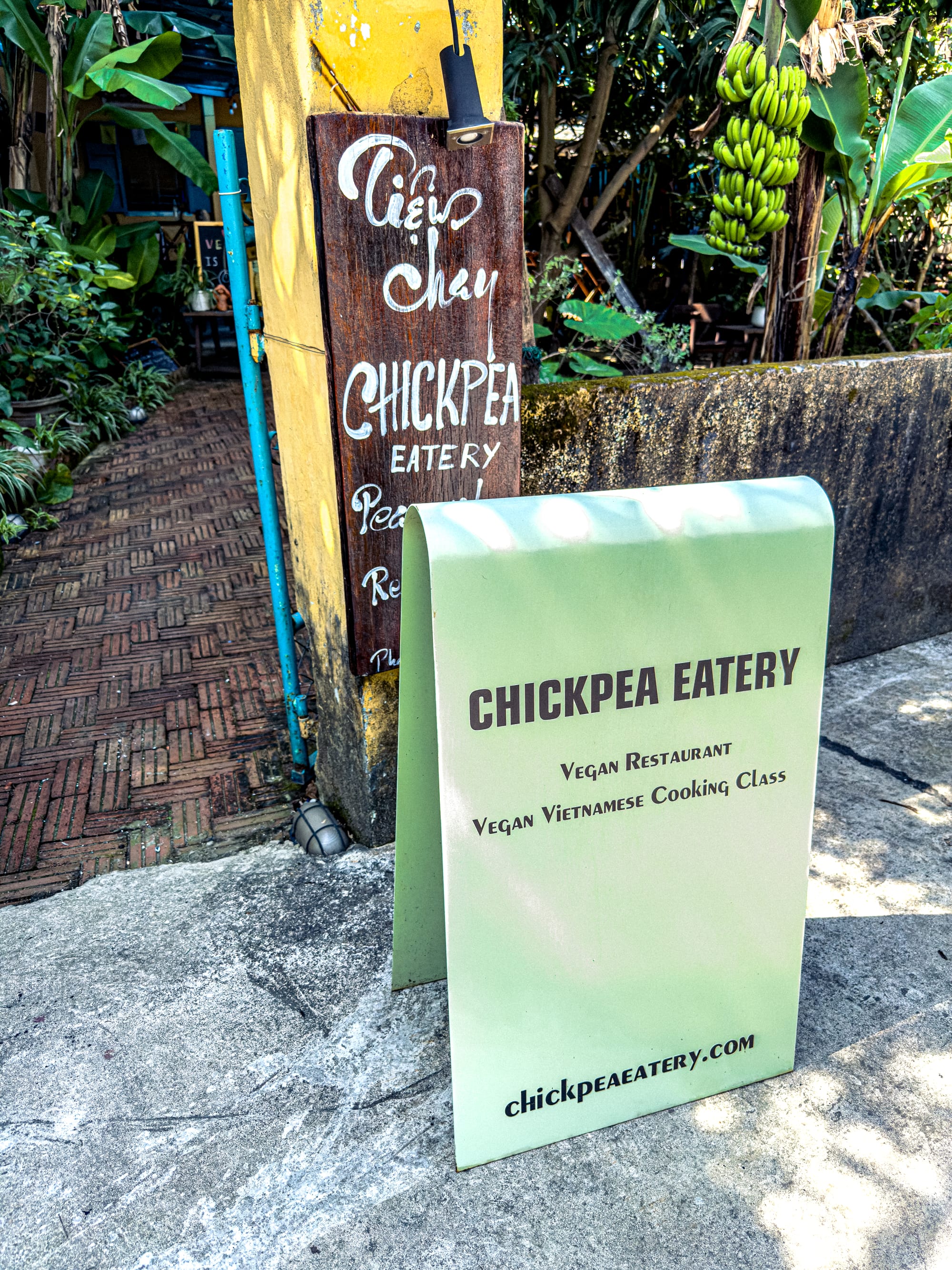
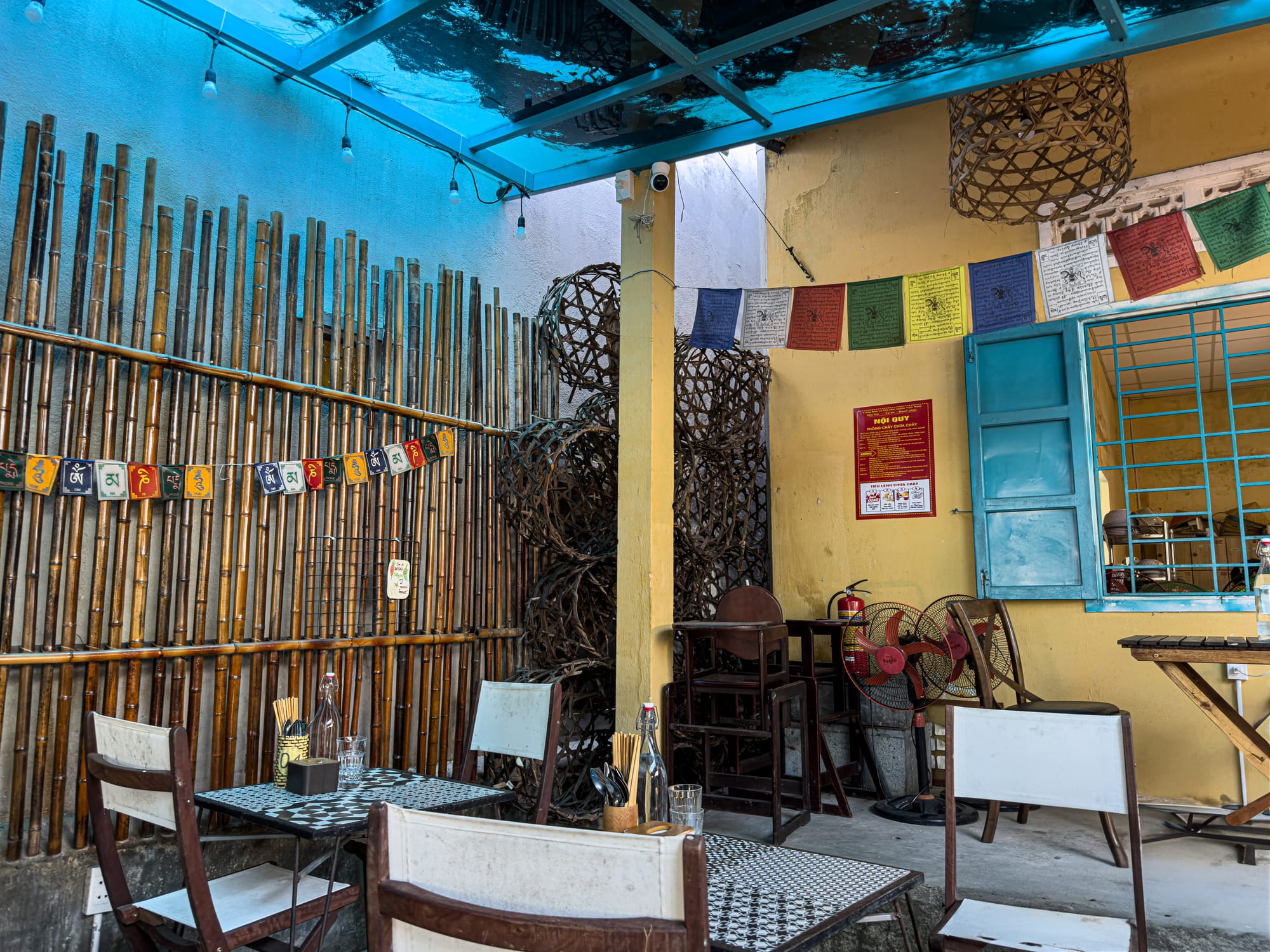
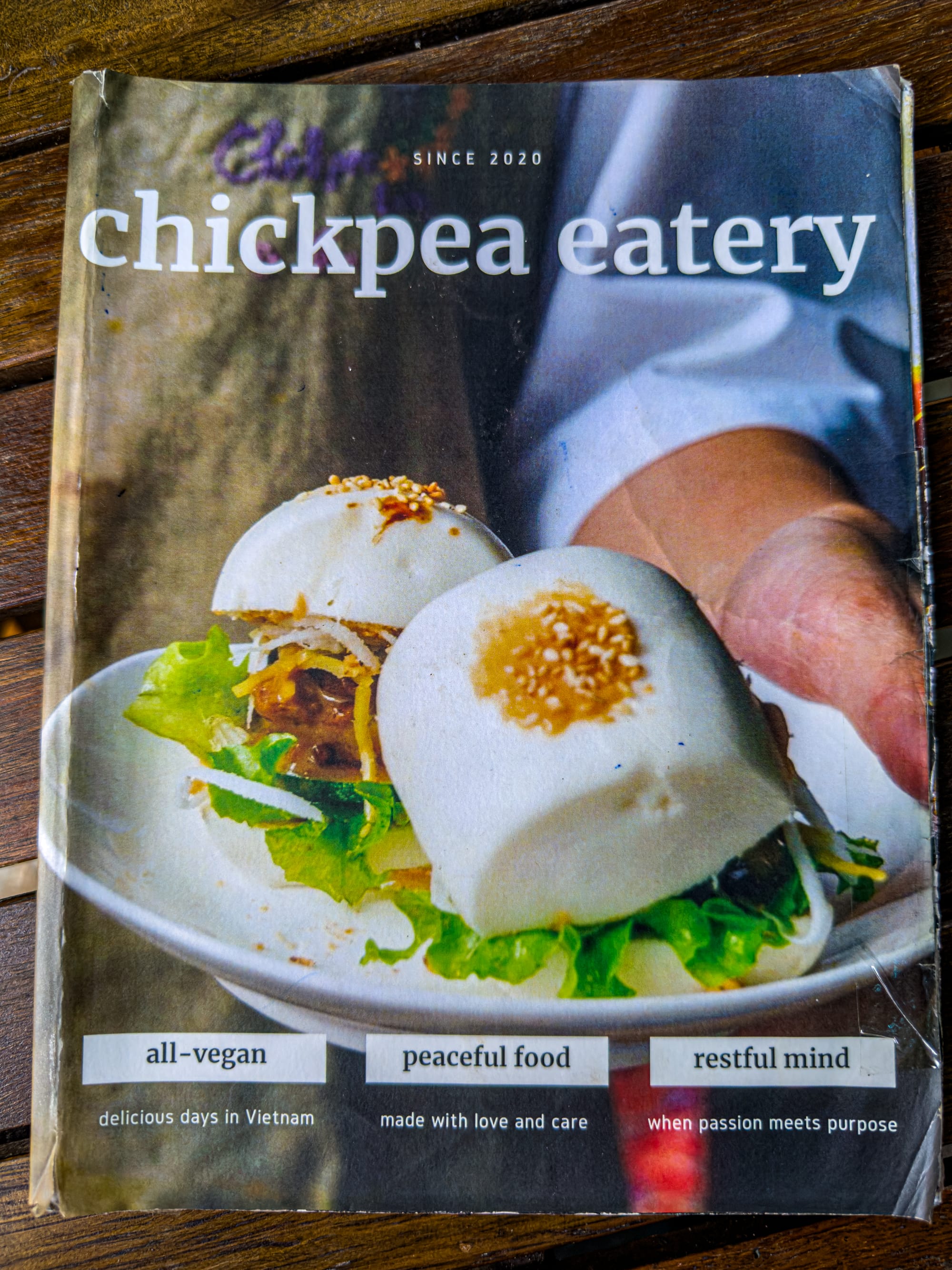
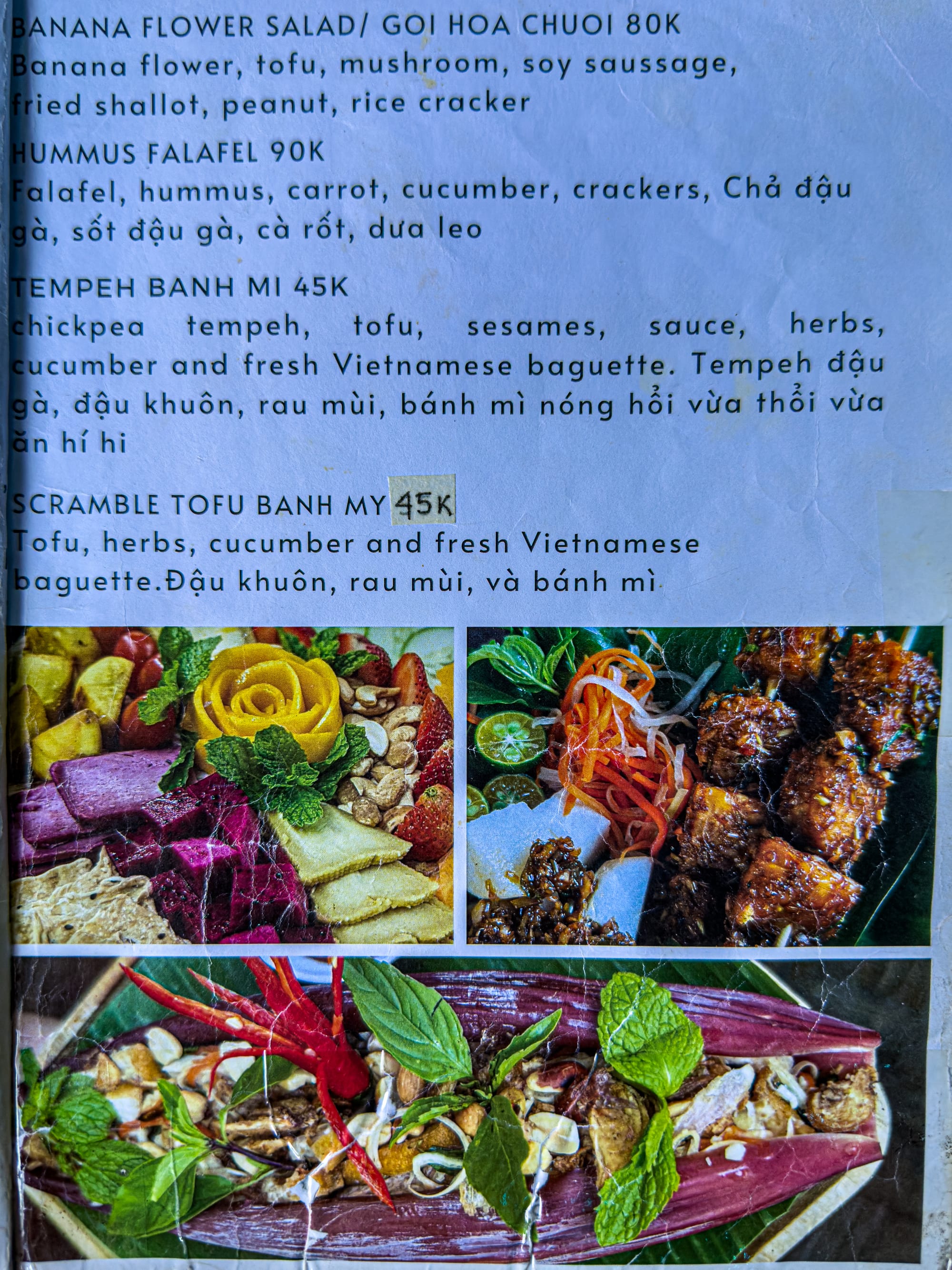
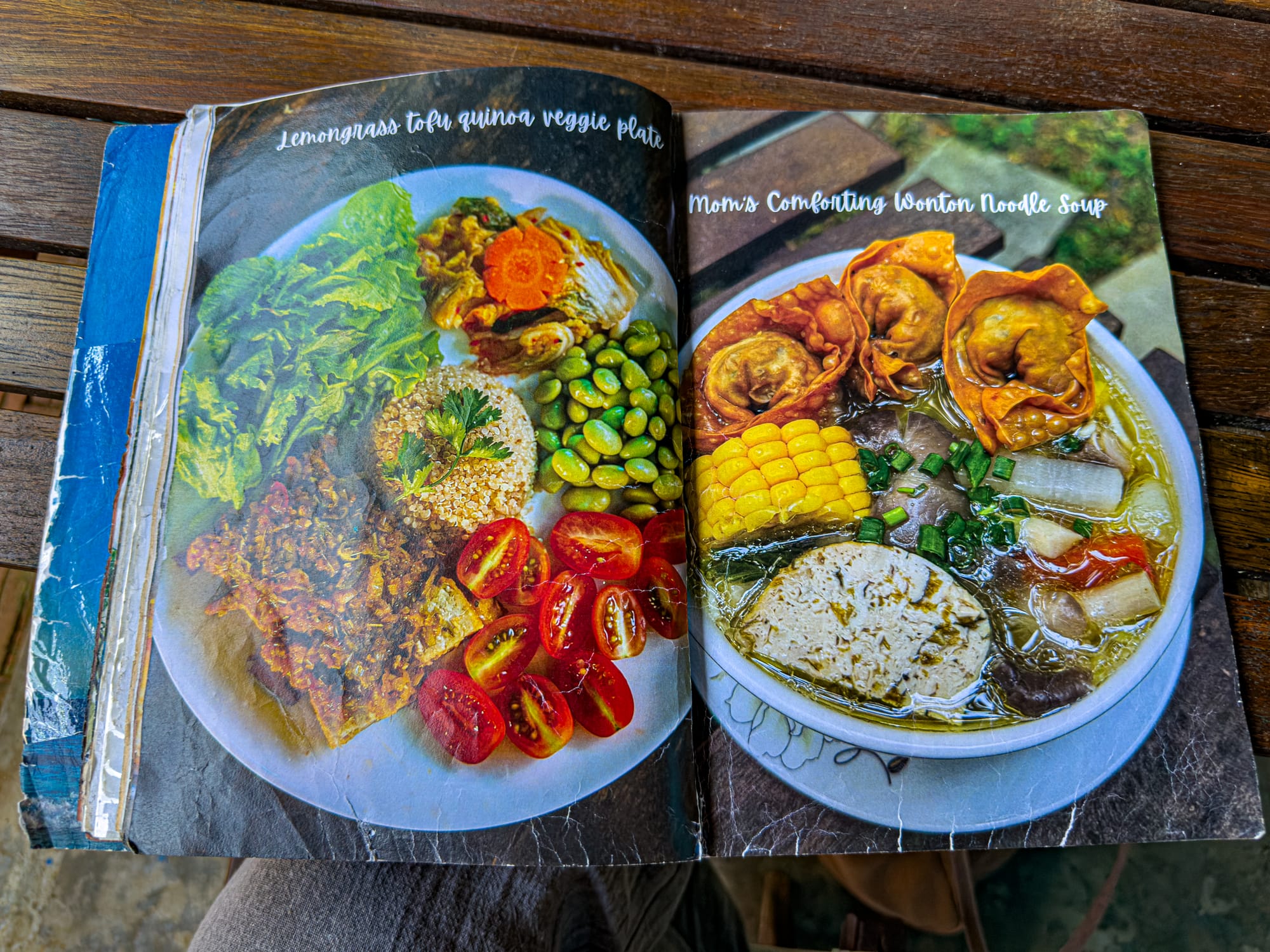
The class is hosted in Chickpea’s courtyard, an airy, open space that feels like both a garden and a dining room. Bamboo and wooden details frame the space, while overhead strings of prayer flags and lanterns ripple in the breeze. The courtyard is shaded enough to be cool in the midday sun but still filled with shifting natural light.
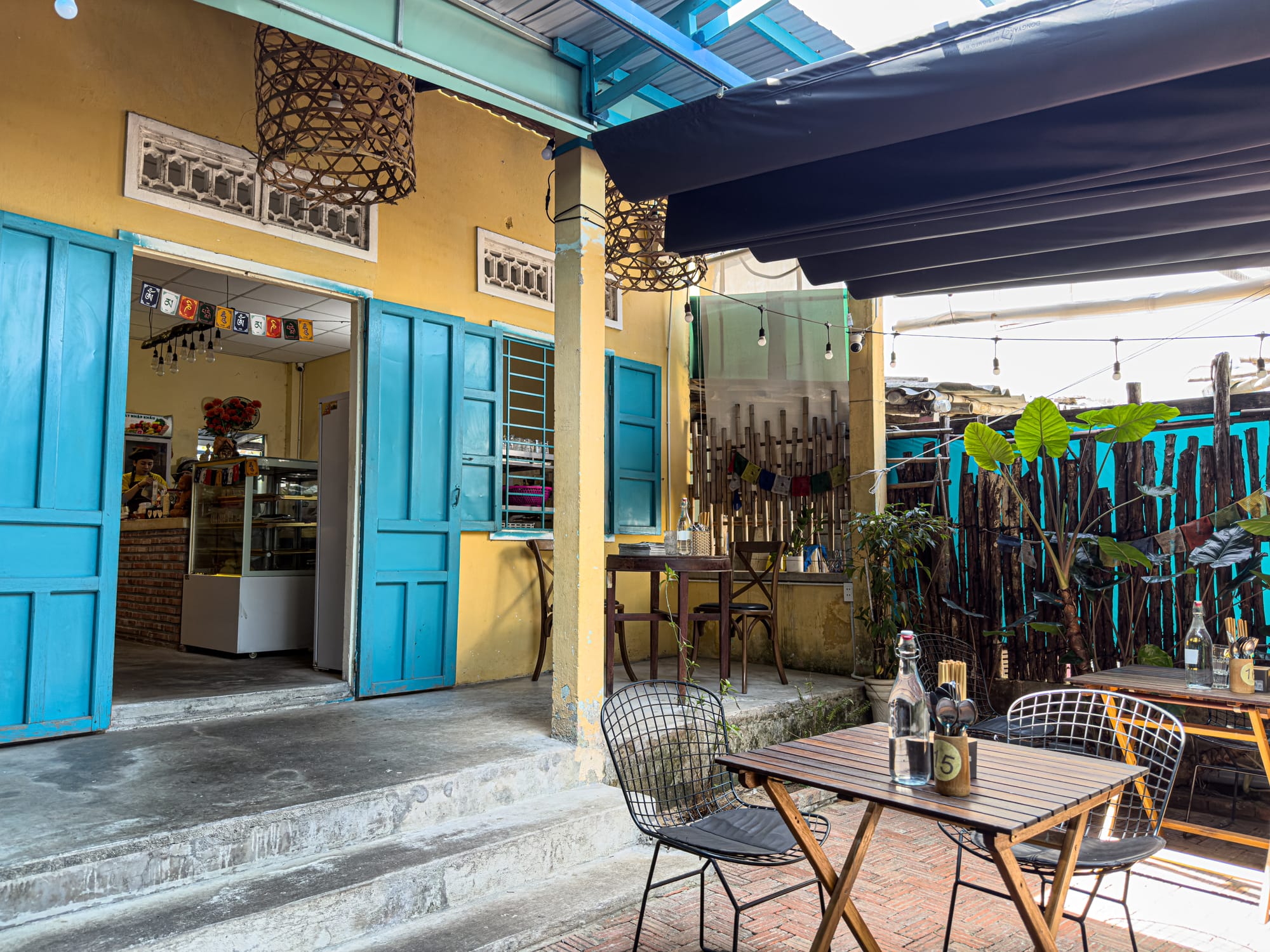
Long tables are set up with individual stations: knives, cutting boards, burners, bowls of fresh vegetables, herbs, and sauces. It immediately feels both communal and intimate—a gathering of strangers who will, for a few hours, become co-cooks, sharing in abundance and learning together. Unlike some classes where cooking tasks are divided, at Chickpea every participant prepares their own version of each dish from beginning to end. This structure makes it deeply hands-on and rewarding—you’re not just observing or helping, you’re cooking. Each dish becomes an expression of your own hand, your own balance of herbs and seasoning.
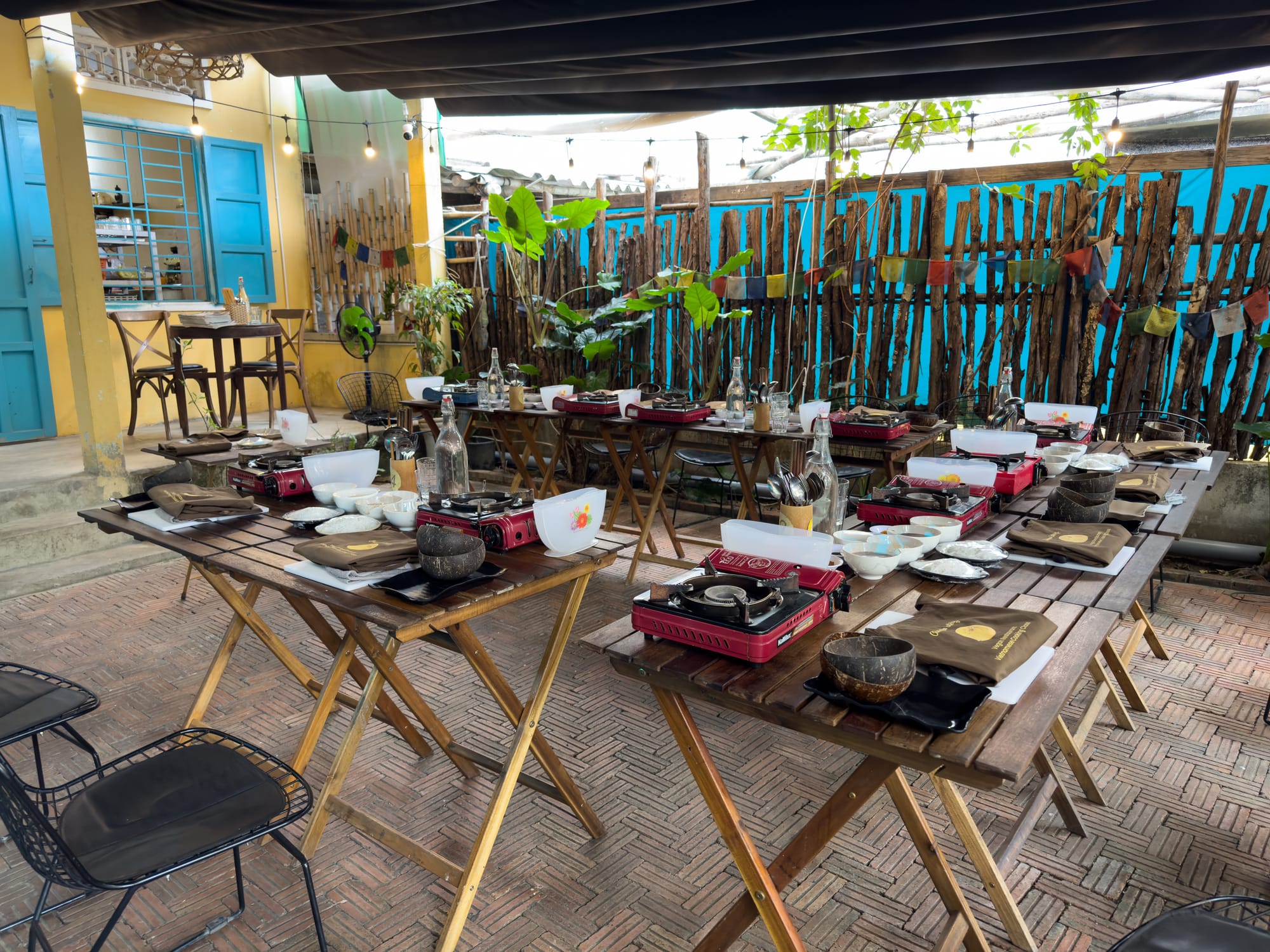
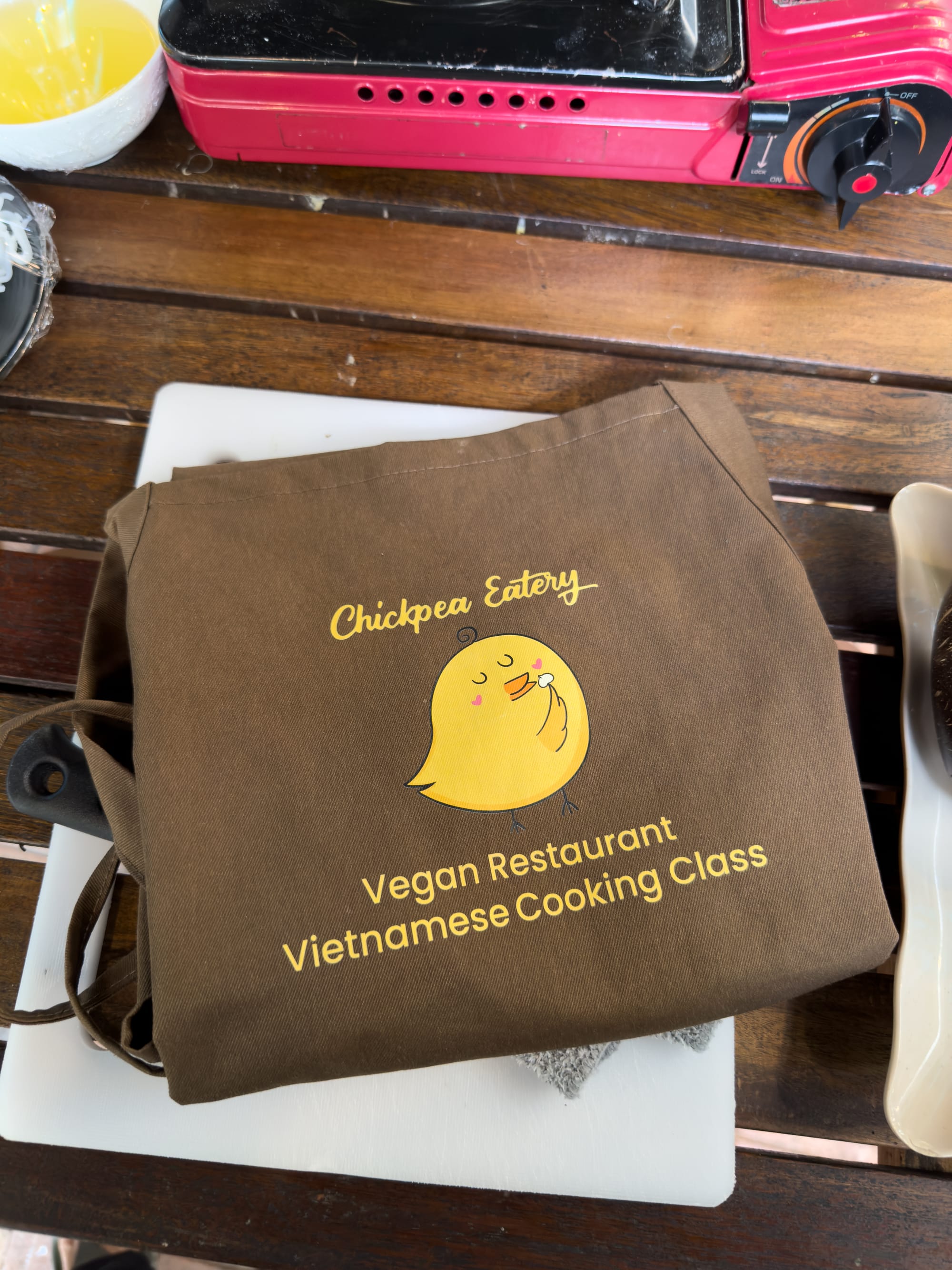
Cooking stations ready for Chickpea Eatery’s vegan class
By the time we sat down, there was already a sense of anticipation in the air. The courtyard held a quiet rhythm, punctuated by the clatter of utensils and the faint aroma of herbs ready to be chopped.
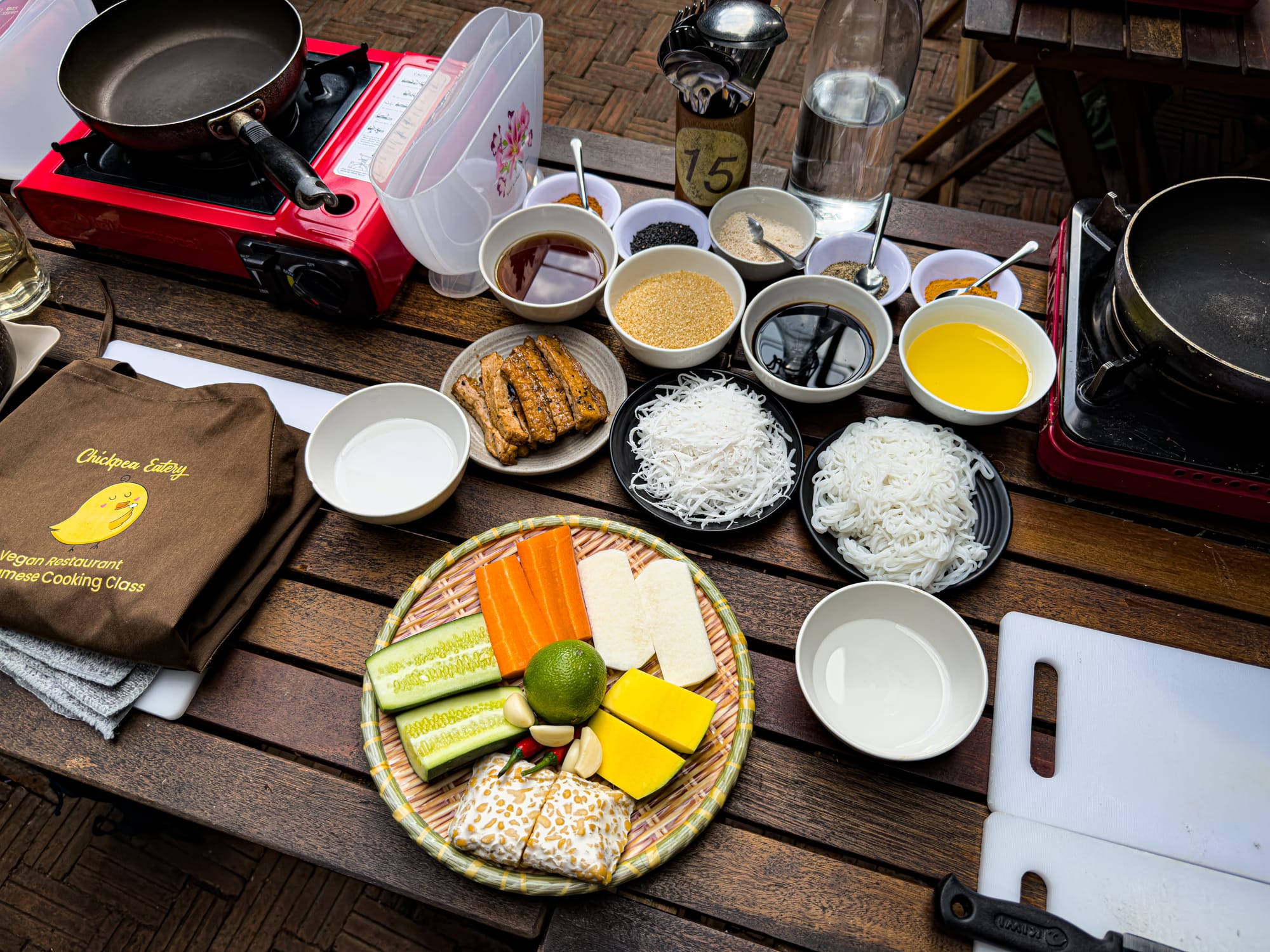
Having already loved Rau Ơi's Eatery's vegan cooking class, we were excited to make even more delicious vegan food.
Learning from the source
The class begins not with chopping or frying but with a walk into the garden itself. The guide pauses beneath a banana tree and shows us how its blossom, heavy and layered like petals of a secret fruit, will later be shredded into a salad. This moment set the tone for the day: cooking not as an isolated activity but as a continuation of the land, a cycle that begins with what grows here and now. Standing in the courtyard with banana blossoms overhead, we could feel the closeness of the ingredients—the food was not arriving from elsewhere but from the soil just beneath our feet.
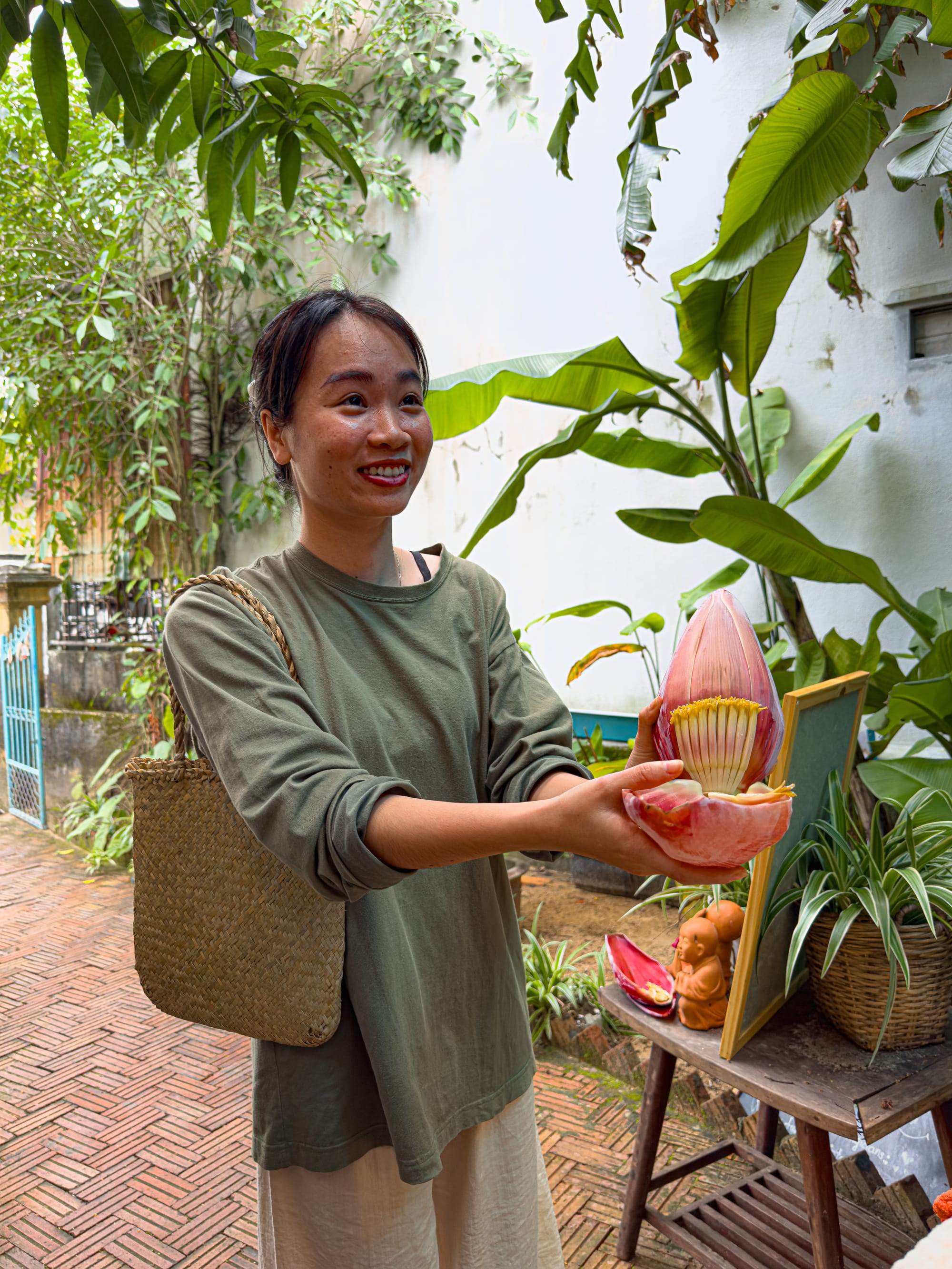
Soon after, we stepped beyond the courtyard to a neighborhood market. Unlike the large and often crowded Tân An Market, this was a smaller, more local market—intimate in scale but overflowing with color. Stalls brimmed with baskets of mint, lemongrass, basil, and Vietnamese coriander, their scents mingling in the humid air.
Women sat cross-legged behind pyramids of mangoes, papayas, and rambutan. Others offered freshly made tofu, sheets of pliant tofu skin, seitan cut into neat strips, and, most impressively, homemade vegan tempeh.
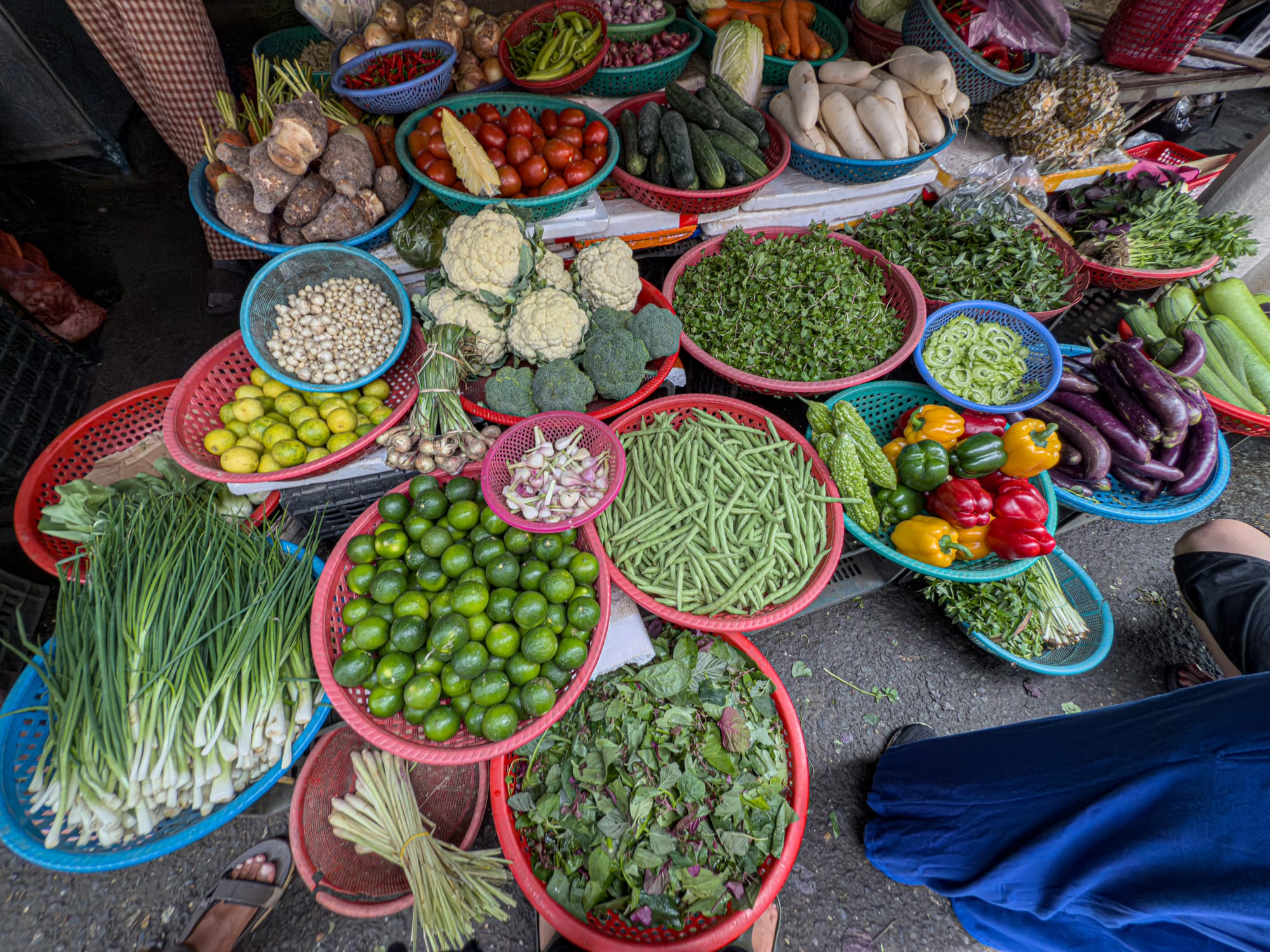
We tasted as we walked: juicy slices of jackfruit, tart bites of starfruit, sticky-sweet longan, and even small samples of chewy vegan meat alternatives that artisans had crafted to replicate traditional textures. The experience was as much about tasting as it was about context—seeing where the ingredients came from, meeting the people whose daily work sustains this food culture.
The market tour stretched into a sensory immersion. We noticed the textures of woven baskets, the subtle variations in color between different herbs, the conversations between vendors and their regular customers. While the market was smaller and less busy than some others, it carried a distinct energy of everyday life. There was no rush, no tourist performance—only people exchanging food, stories, and gestures. Returning to the courtyard after this excursion, our bags carried more than produce—they carried the sense of belonging to the rhythms of Hội An’s foodways.
The cooking begins
Back at the courtyard, the setup felt like an invitation to create. Each workstation was lined with bowls of pre-washed vegetables, neat bundles of herbs, small containers of oil and spices, and the glint of sharp knives waiting to be put to use. The air smelled of lime, coriander, and the faint smokiness from pans beginning to heat.
Fresh spring rolls
We began with one of Vietnam’s most iconic dishes: fresh spring rolls. Yet Chickpea’s take offered a surprising twist—the star ingredient was their homemade chickpea tempeh. Unlike the soybean version, this had a lighter, nuttier flavor, with a firm texture that held beautifully when rolled. Alongside it, we layered slivers of cucumber, jicama, carrot, garlic, and juicy slices of mango, all tucked into sheets of rice paper softened just enough to fold.
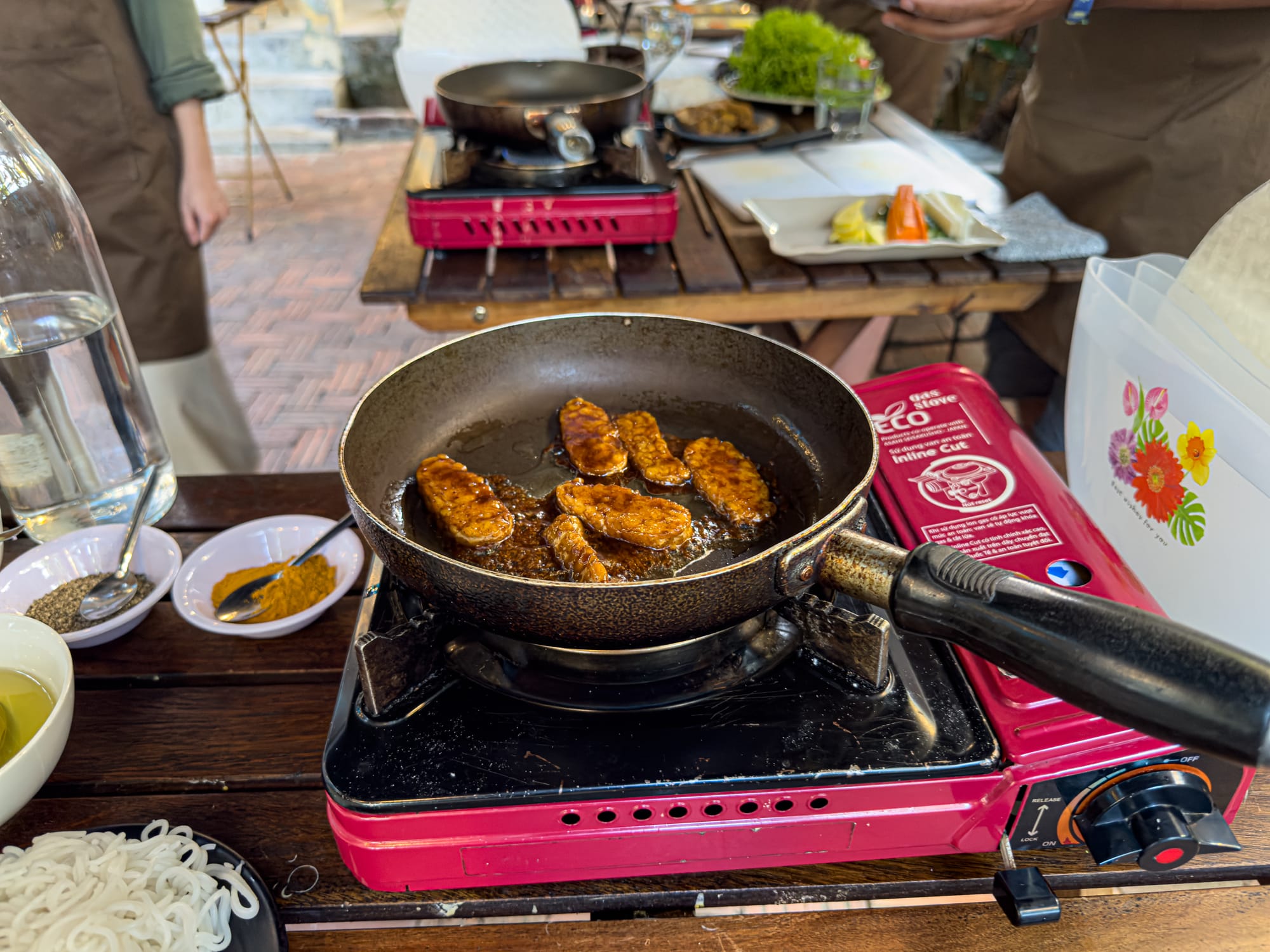
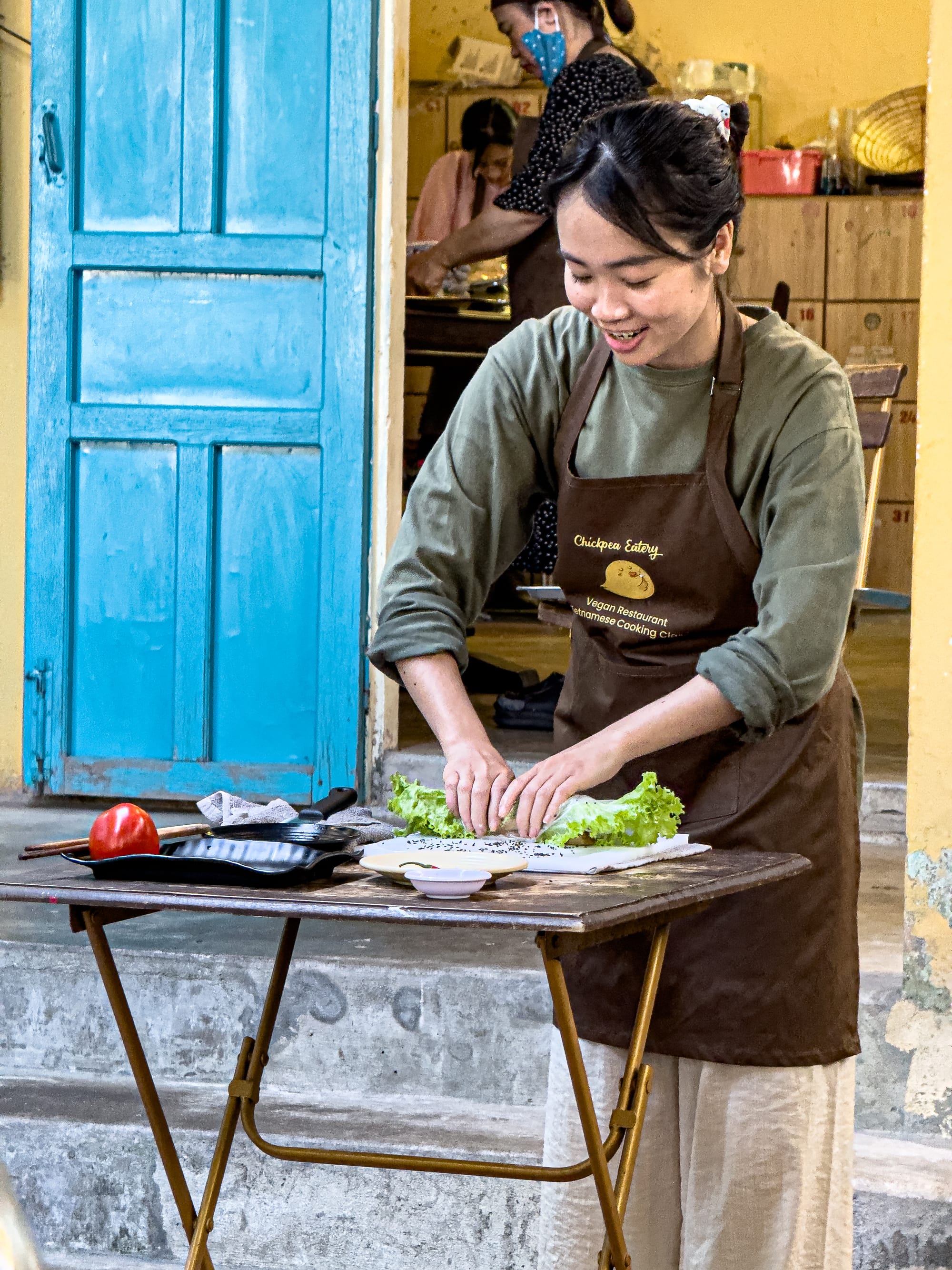
From frying homemade chickpea tempeh to rolling fresh spring rolls at Chickpea Eatery
A dipping sauce was prepared on the side—salty, sweet, tangy, with a touch of heat. Rolling the spring rolls was both meditative and playful, a careful folding of flavors into edible parcels.
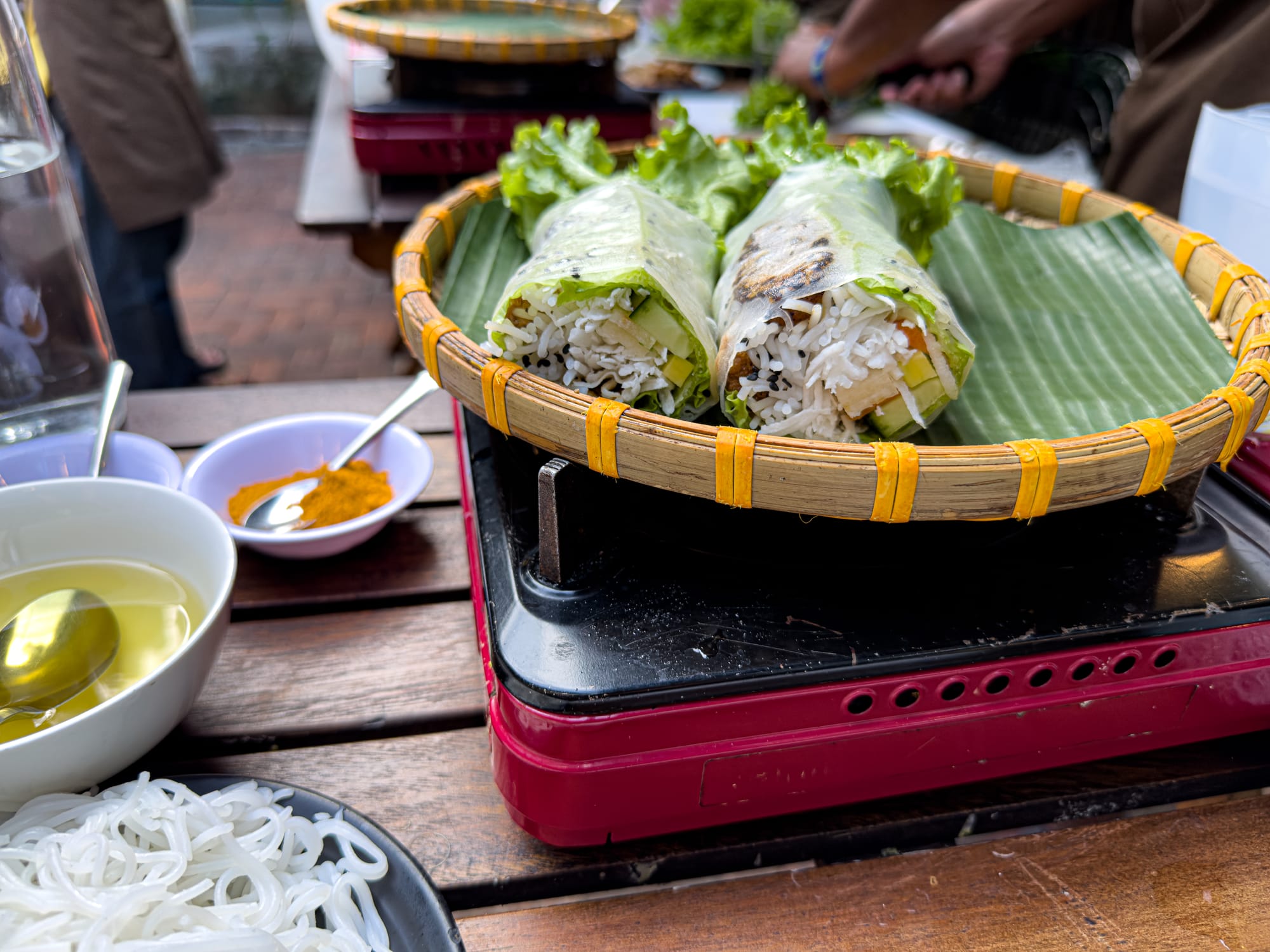
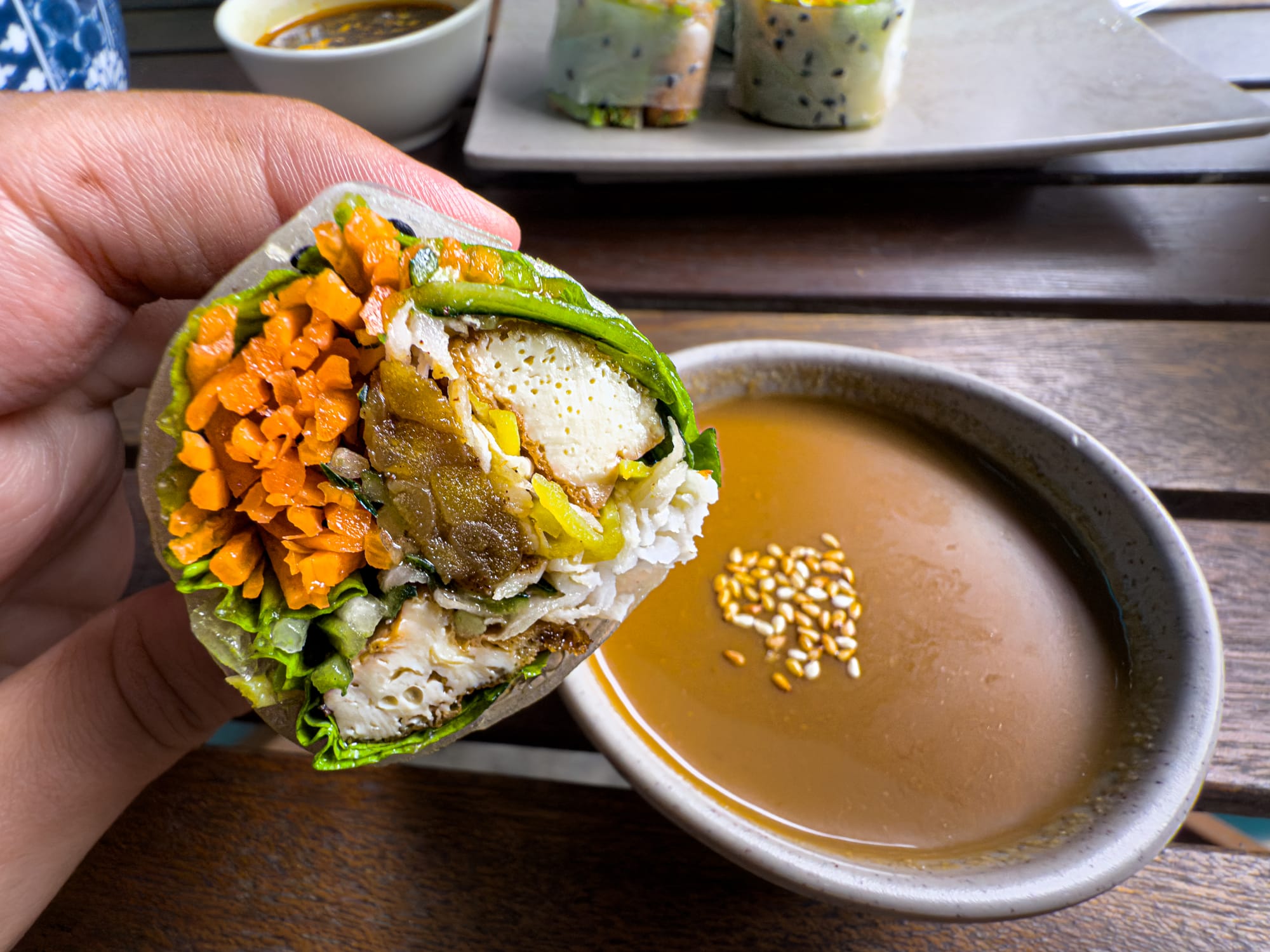
Freshly rolled vegan spring rolls with chickpea tempeh and dipping sauce
Each person prepared six rolls, and the sheer quantity felt abundant. We ate a couple right away, dipping into the sauce while they were still fresh and cool, then set the rest aside for later.
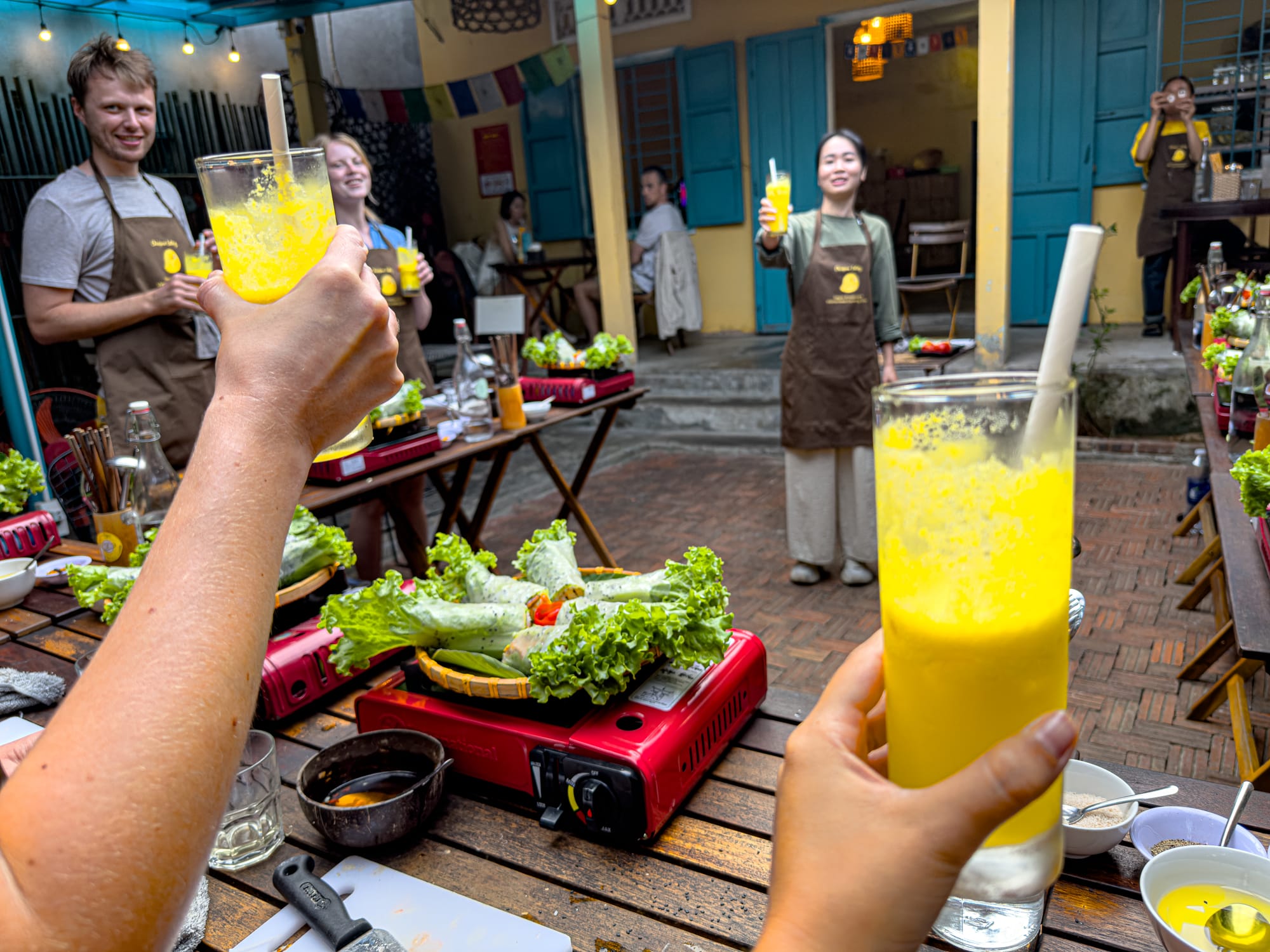
At that point, glasses of fresh pineapple juice appeared—chilled, fragrant, and sweet without being heavy. It refreshed the palate and paired beautifully with the rolls. It was one of those small gestures of hospitality that make an experience linger in memory: not just teaching us how to cook, but making sure we felt cared for while doing it.
Vegan chicken salad
The next dish layered textures in ways that Vietnamese cuisine excels at. Chickpea’s vegan chicken salad combined tofu skin—a staple in local vegan cooking—with another regional vegan meat, diced mango, shredded carrot, lime juice, thinly sliced onion, and a generous helping of Vietnamese mint.
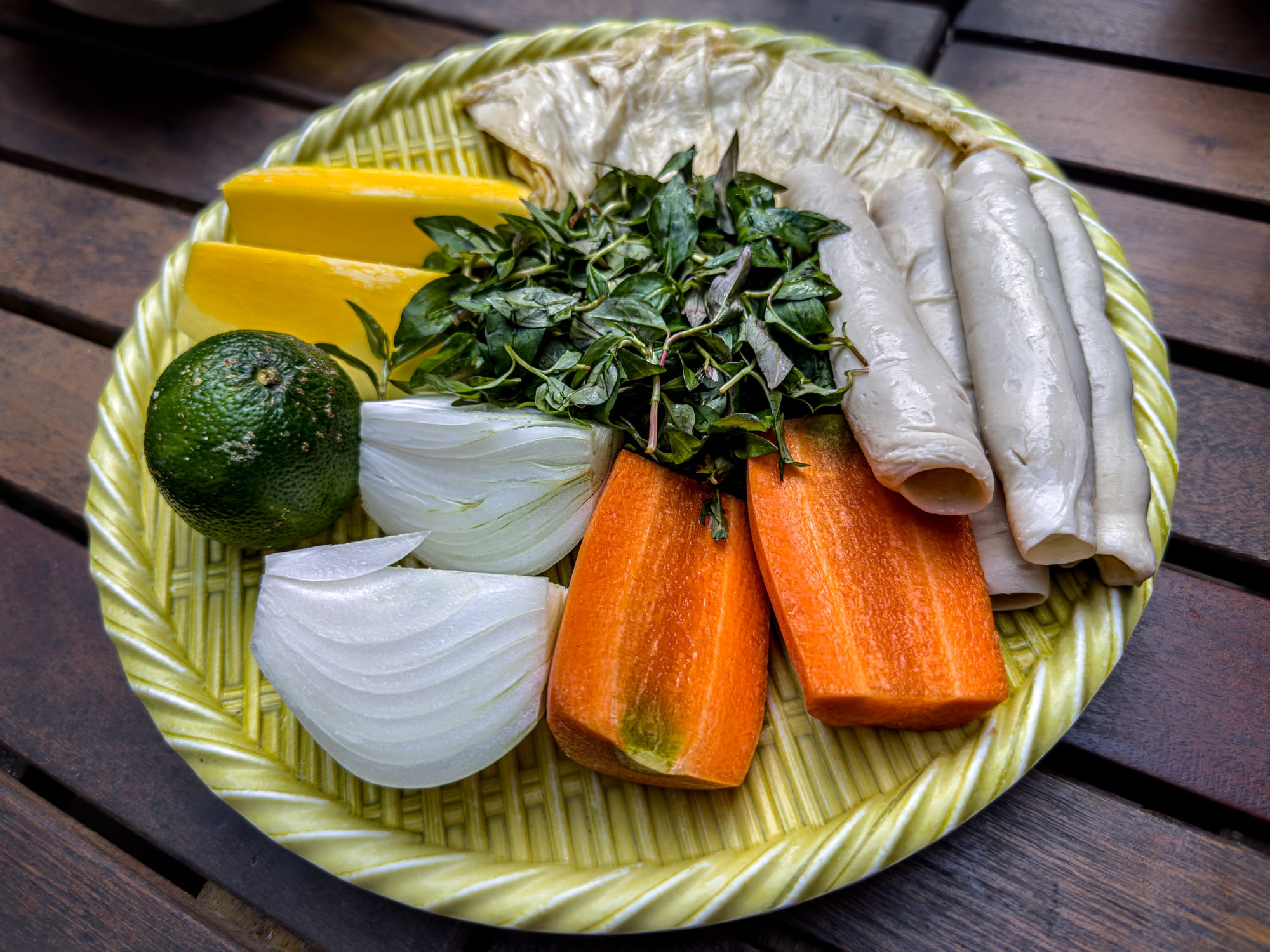
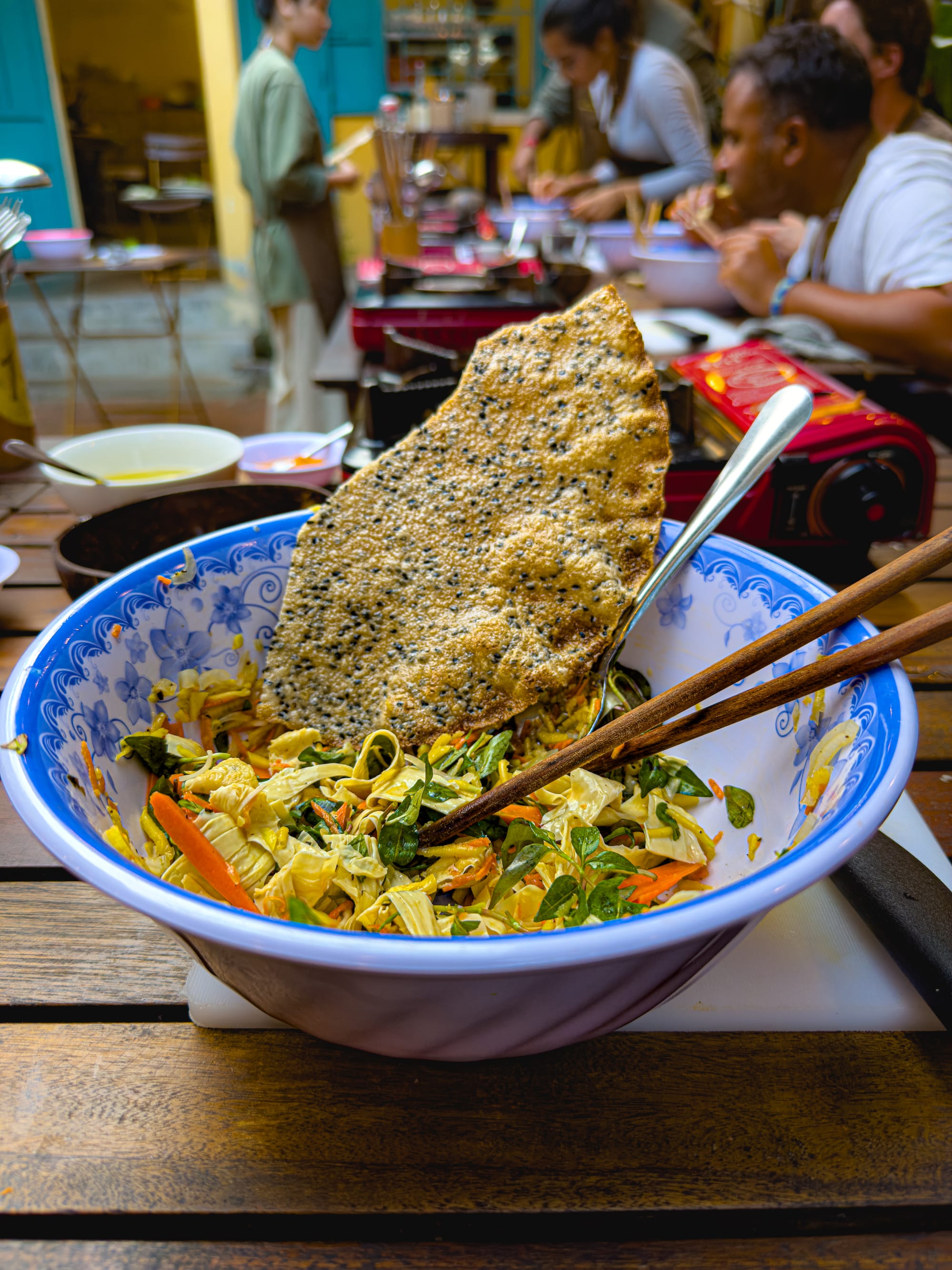
Vegan chicken salad ingredients and finished dish with rice cracker
Tossed together, the result was crisp, tangy, herbaceous, and deeply satisfying. Served with large rice crackers, the dish became interactive—break a piece of cracker, scoop up the salad, crunch into a perfect bite of freshness and depth. The salad carried the spirit of Vietnamese street food: simple ingredients, carefully combined, transformed into something extraordinary.
There was also a pleasure in the way it came together quickly. No simmering broth or complicated preparation—just chopping, tossing, and tasting. Yet the flavors were complex, layered with citrus, herbal brightness, and the satisfying chew of tofu skin.
Bánh xèo
The final dish was perhaps the most theatrical: bánh xèo, the sizzling Vietnamese pancake. Traditionally made with rice flour, Chickpea’s version used chickpea flour—a nod to their namesake and an ingredient that gave the batter an earthy, nutty undertone. Turmeric was added to give it a golden hue, and the mixture was poured into hot pans where it immediately began to sizzle.
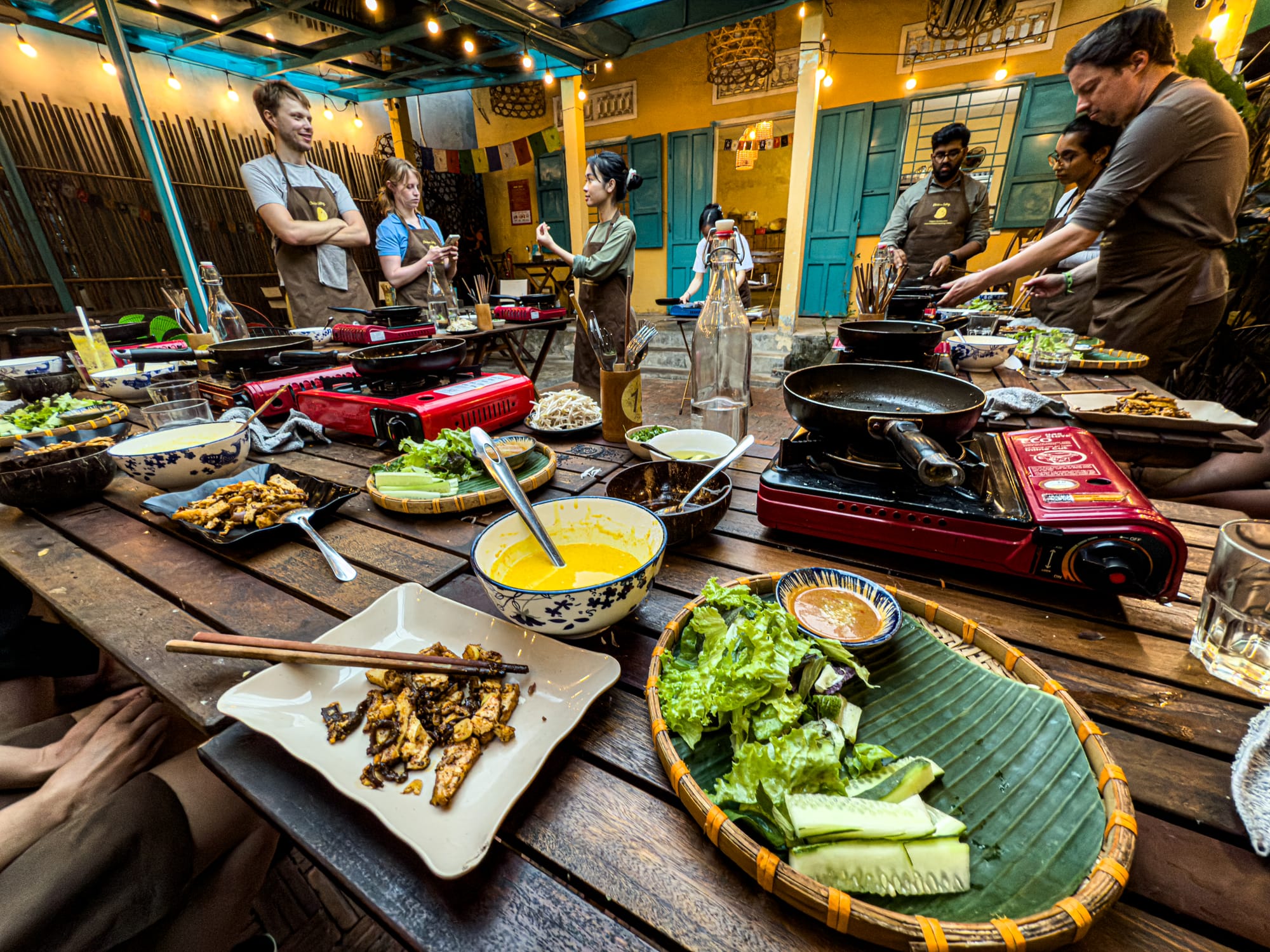
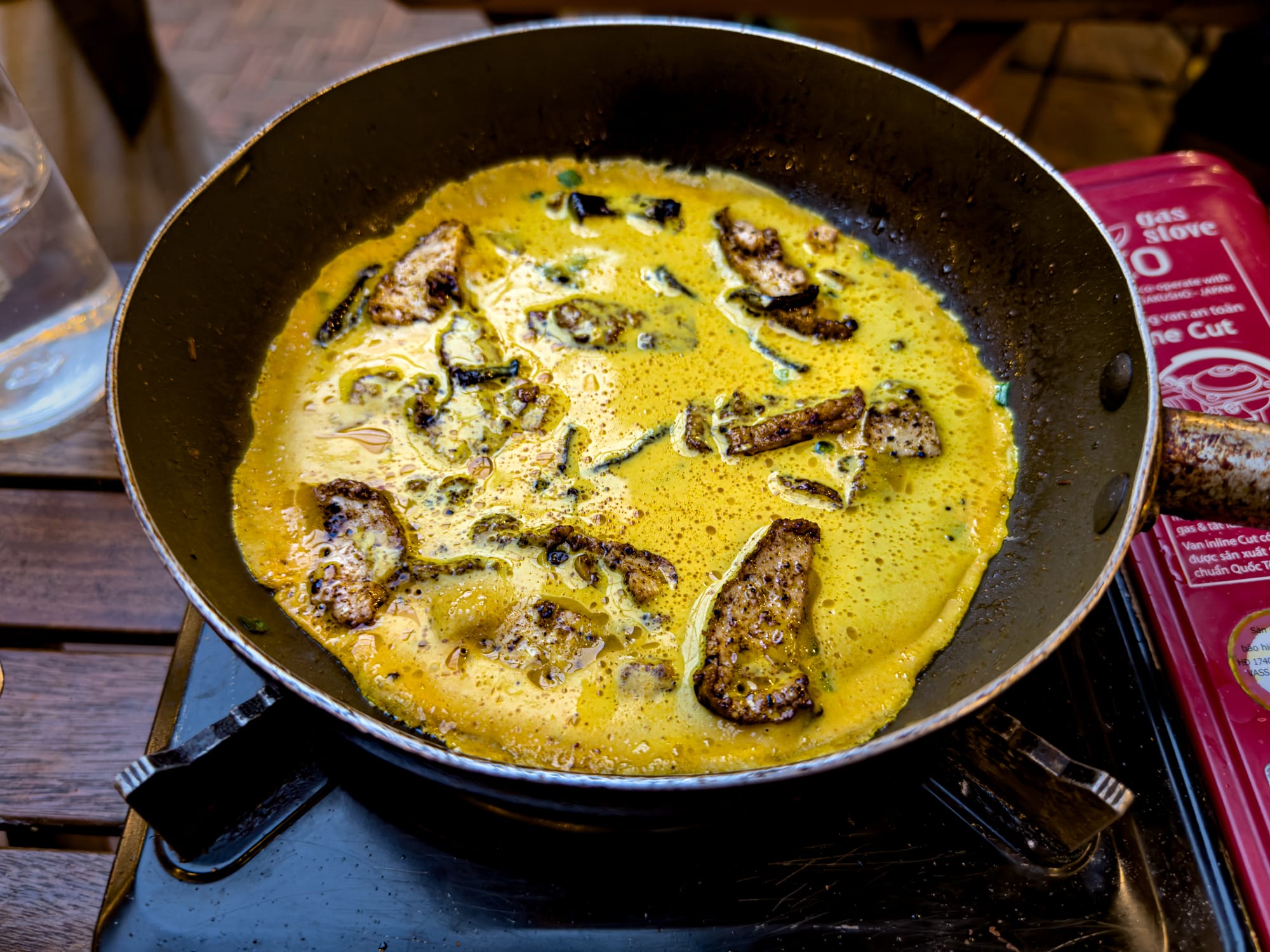
Cooking crispy bánh xèo pancakes in Chickpea Eatery’s courtyard vegan cooking class
The sound alone was intoxicating—crisp edges forming as the middle bubbled, herbs folded in, and mushrooms scattered across the surface.
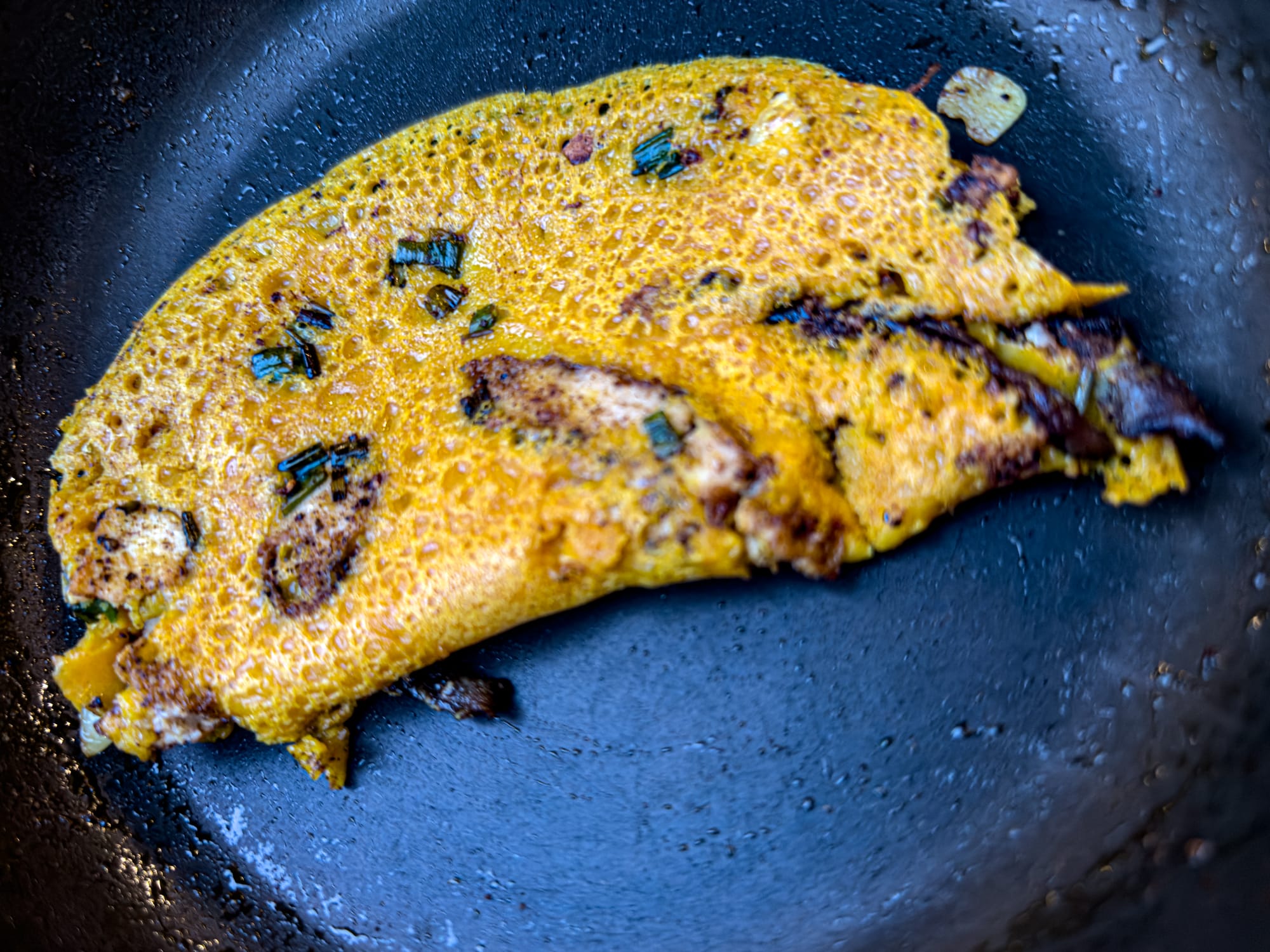
Cooking bánh xèo required timing and a bit of courage—knowing when to flip, when to fold, when to trust that the batter would hold.
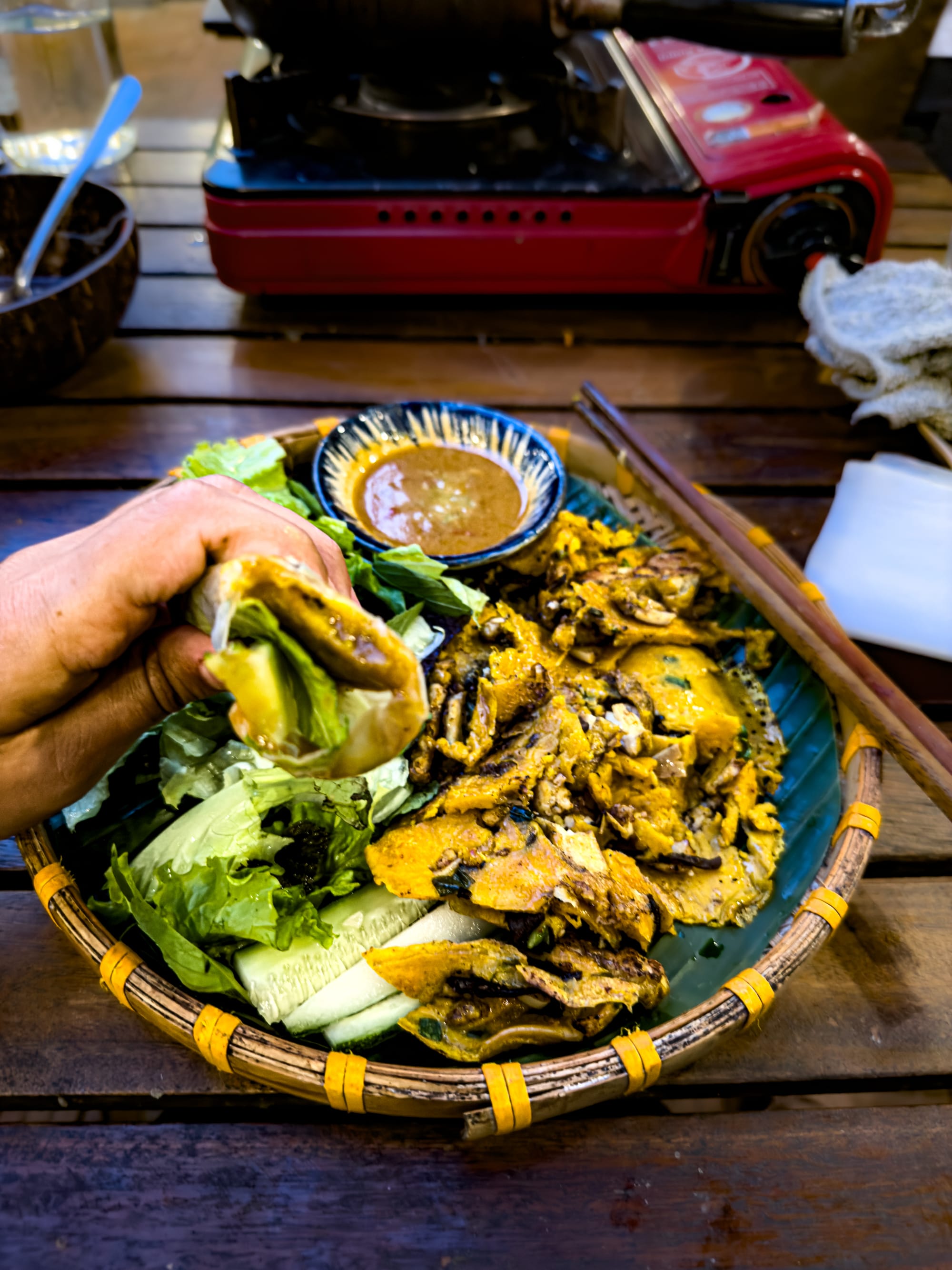
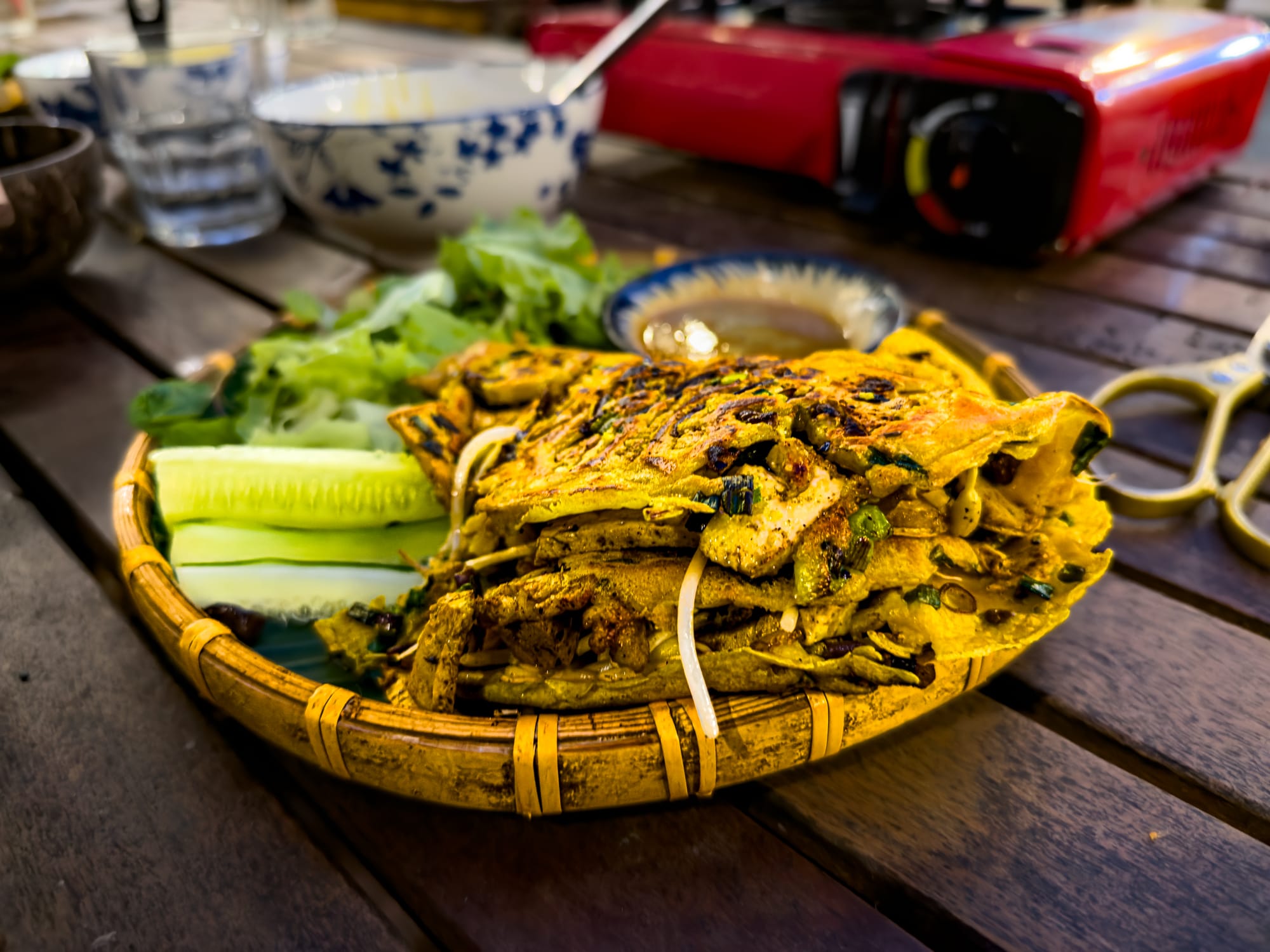
Enjoying bánh xèo with herbs and dipping sauce at Chickpea Eatery
The reward was a pancake both crispy and soft, folded over fresh herbs and eaten with dipping sauce. It was messy in the best possible way: a dish that asked you to use your hands, to bite into layers of crunch and softness, to enjoy the abundance of herbs spilling from its edges. It felt like the crescendo of the class—lively, flavorful, and unmistakably celebratory.
More than a meal
By the time we finished cooking, the table was overflowing. Spring rolls stacked neatly on plates, bowls of salad crowned with herbs, golden bánh xèo folded and ready to be torn apart. And beyond what we ate together in the courtyard, there were leftovers—boxes packed with spring rolls, extra crackers, pieces of pancake. It was enough to provide another meal entirely, a continuation of the class into the following day. That abundance felt emblematic of the experience: generous, thoughtful, and rooted in care.
What stayed with us was not only the food but the rhythm of the day. The slow walk through the market, the hands-on rolling and frying, the small moments of laughter shared across tables. Unlike classes that feel rushed or overly curated, this one unfolded at its own natural pace—stretching just long enough to let us feel immersed, yet never dragging. Time slipped easily, and when we finally left, we carried both full stomachs and a sense of nourishment that reached beyond food.
Beyond the class
Even if you don’t have time for the cooking class, Chickpea Eatery remains one of the most beloved vegan restaurants in Hội An. Their menu is an eclectic blend of comfort food and regional specialties.
Beyond the dishes we cooked, highlights include their hummus plate, rich and creamy with warm bread on the side; black bean quesadillas, perfect for a filling lunch; and cao lầu, the chewy noodle dish unique to Hội An, reimagined in a vegan version that still captures the heart of the original.
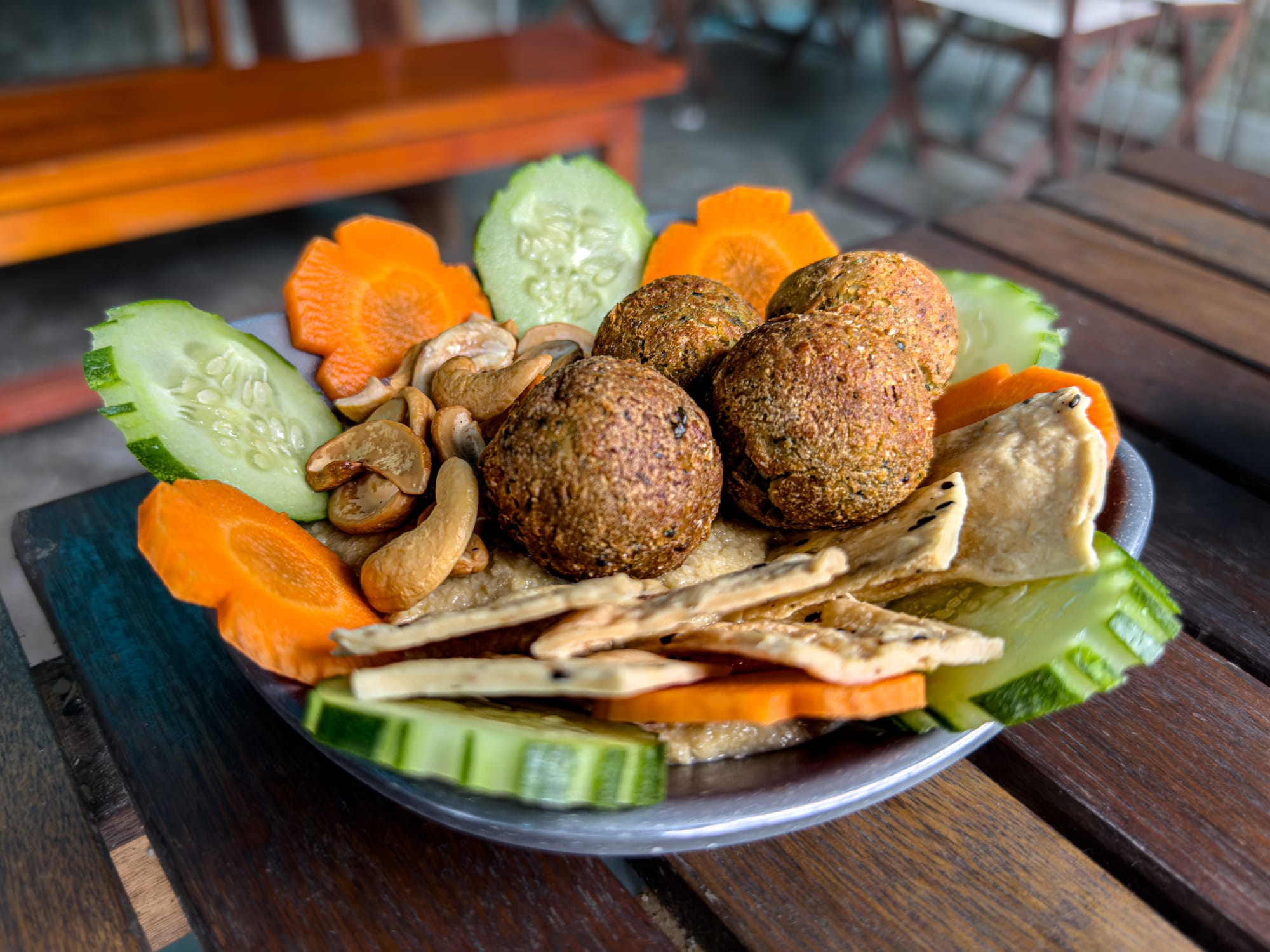
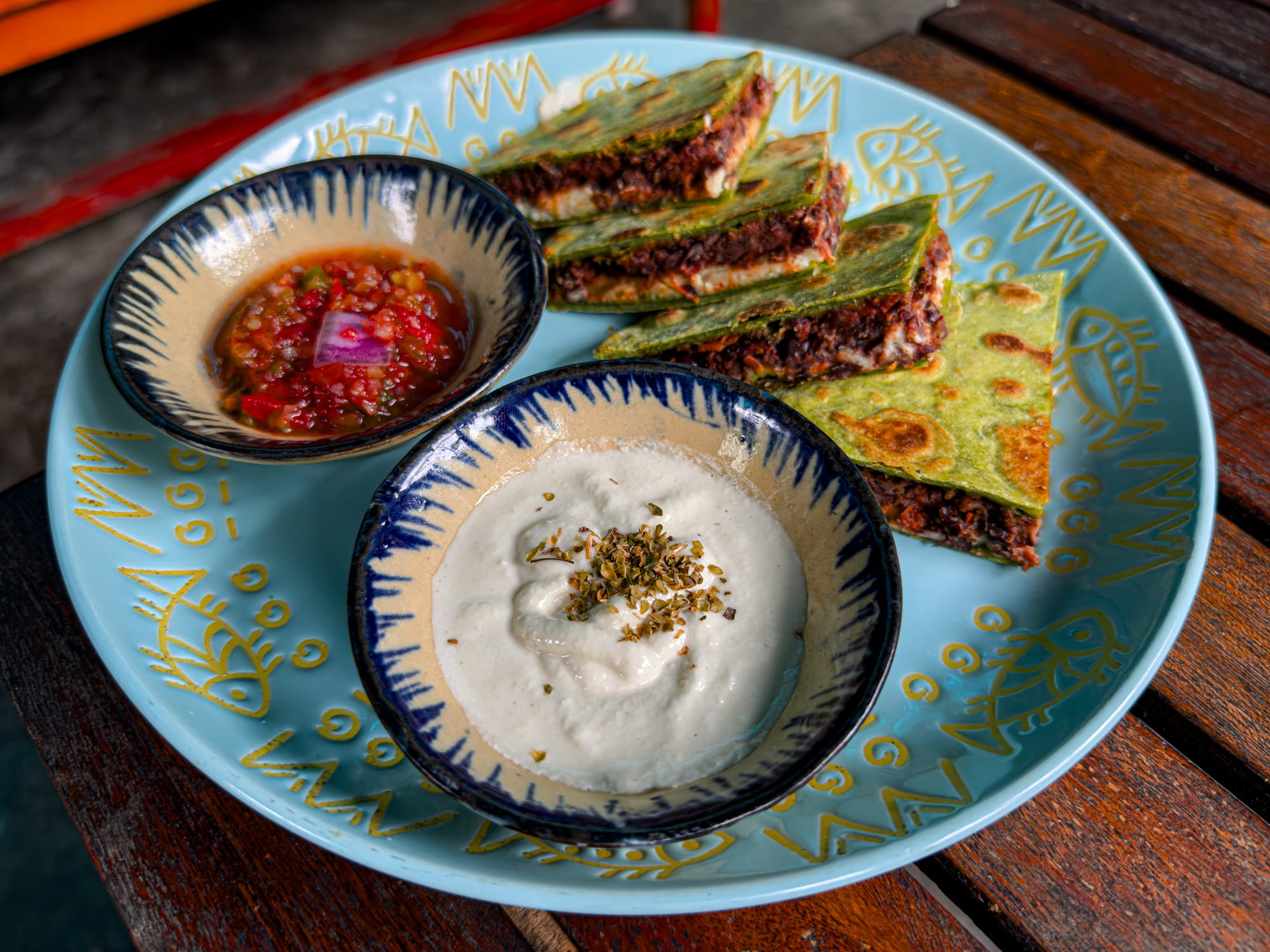
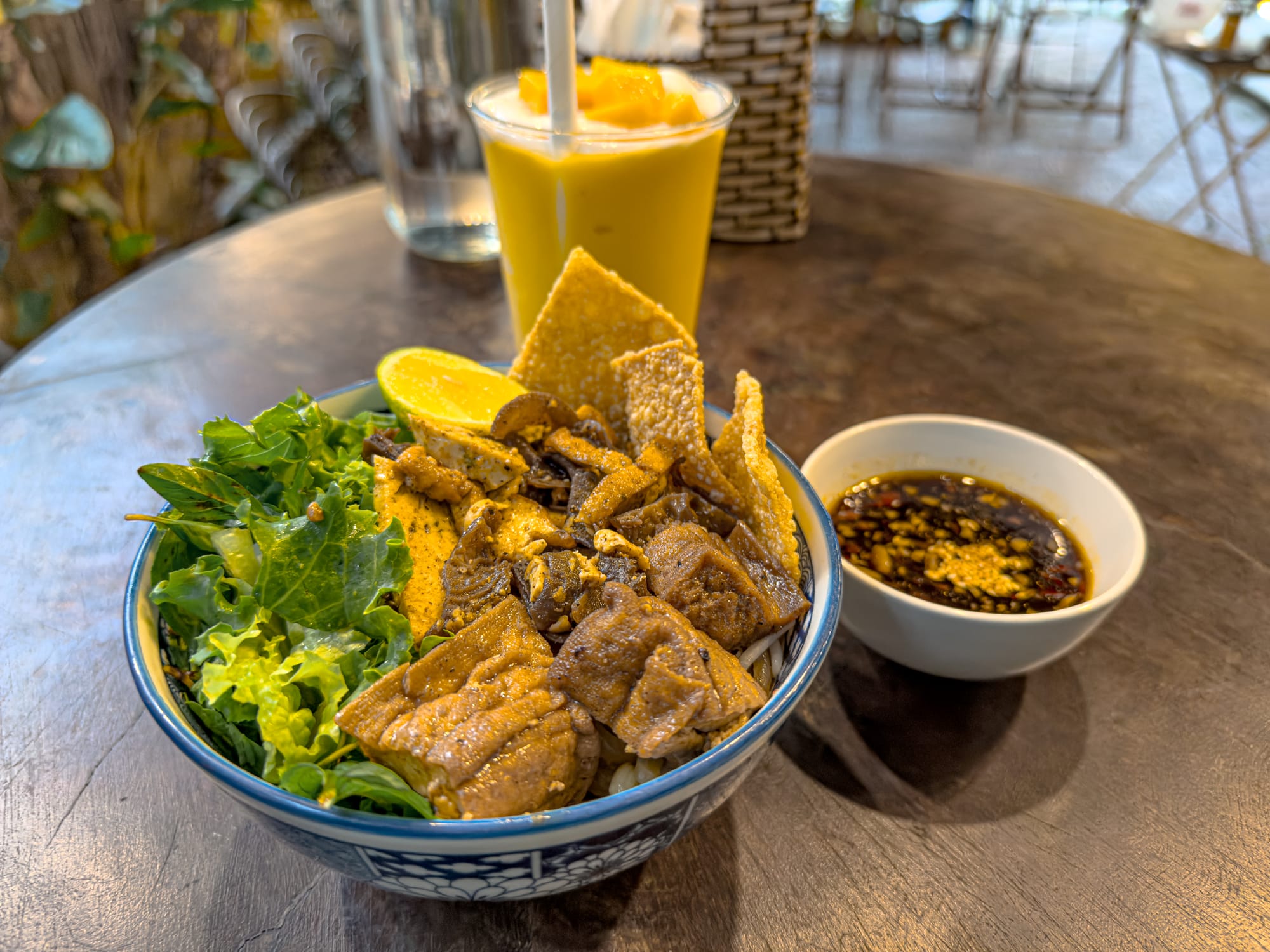
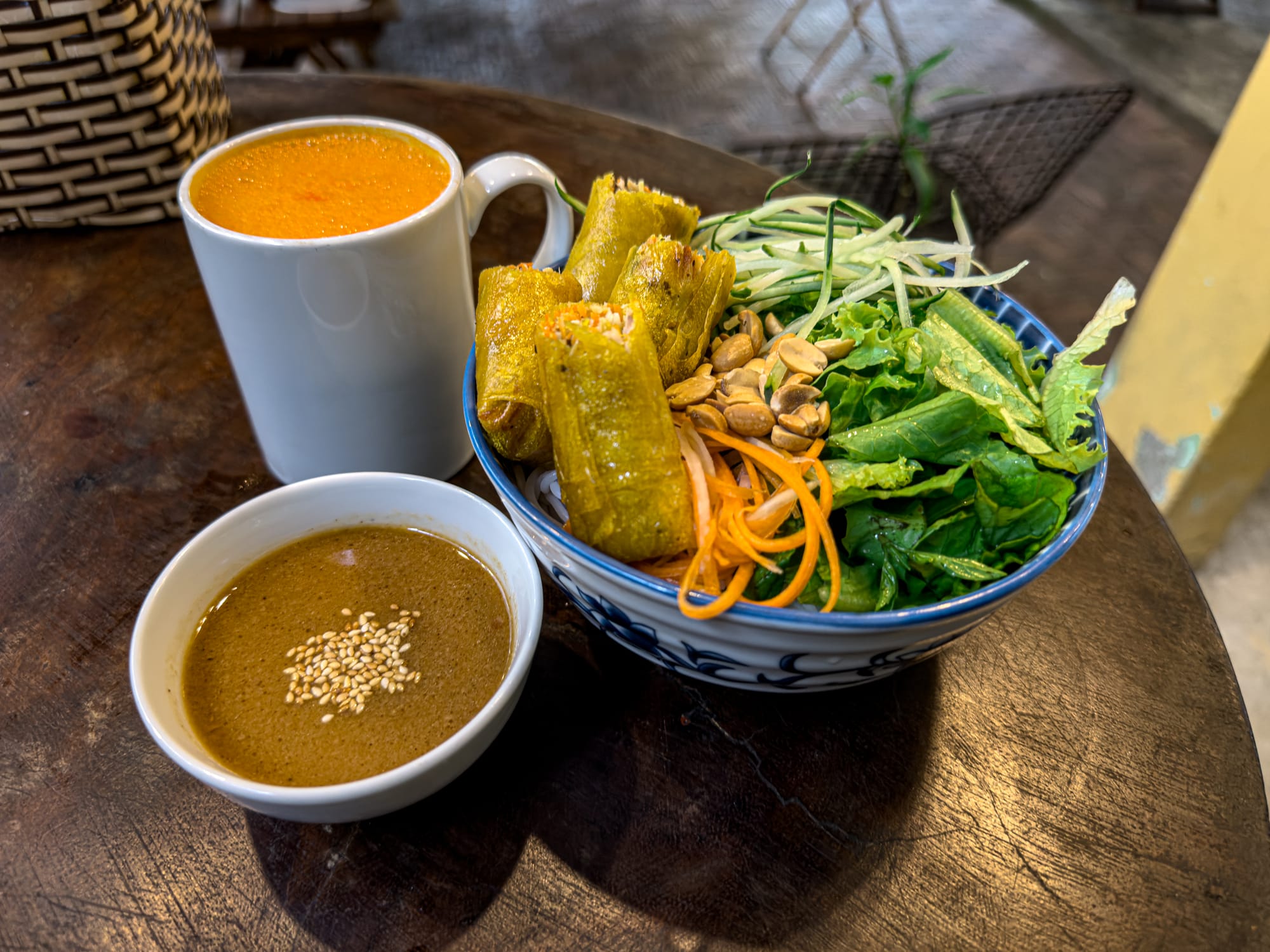
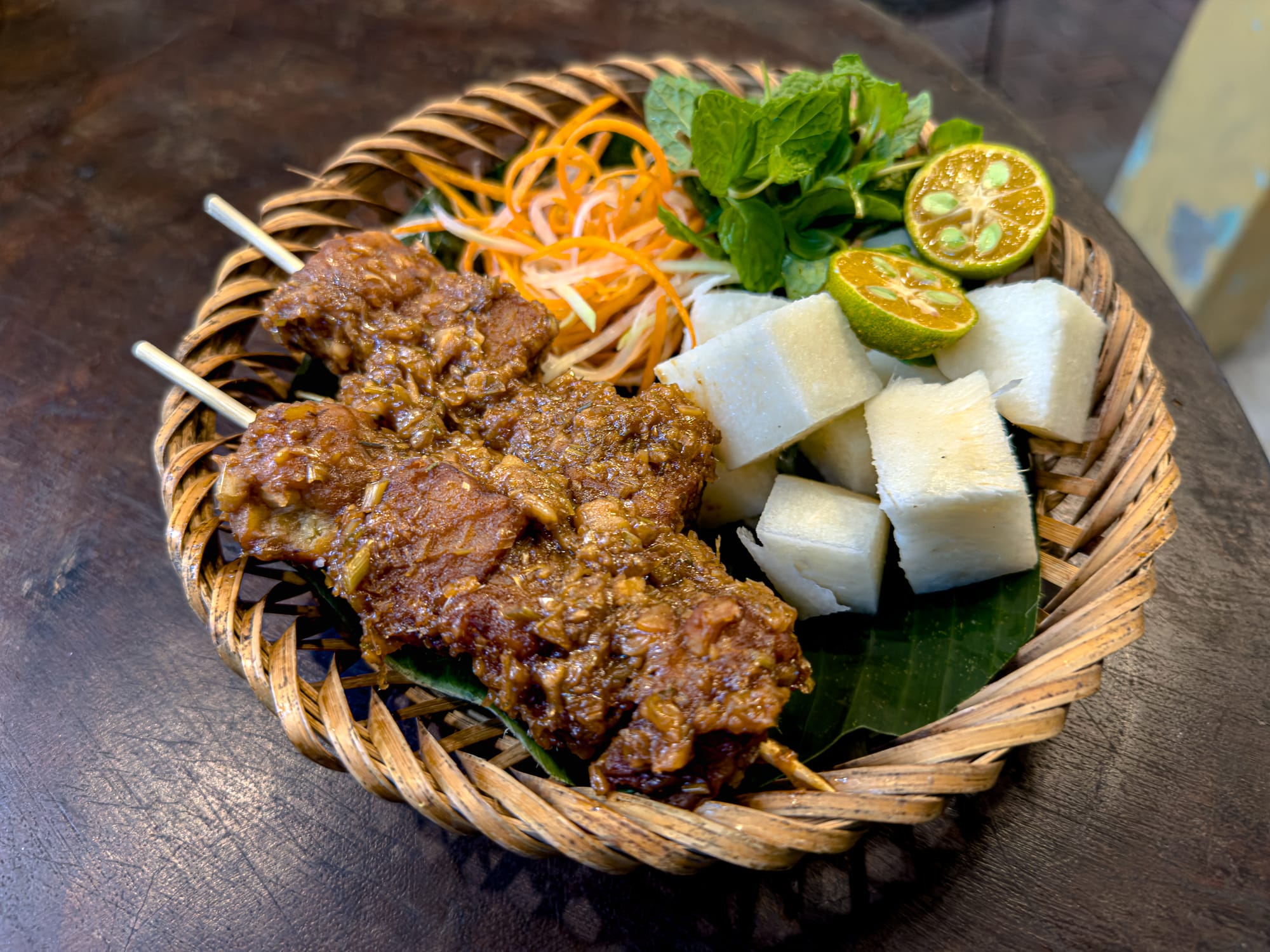
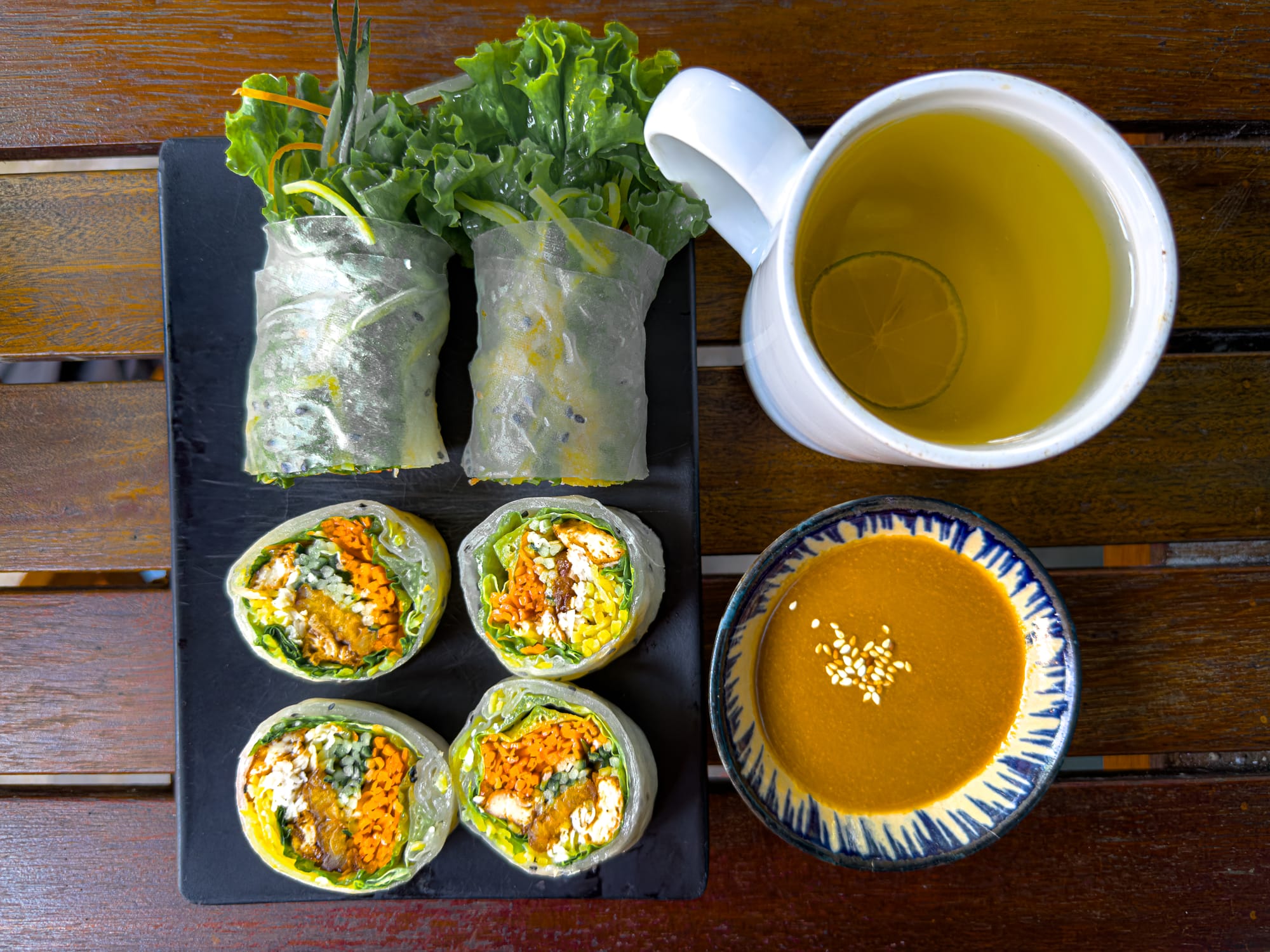
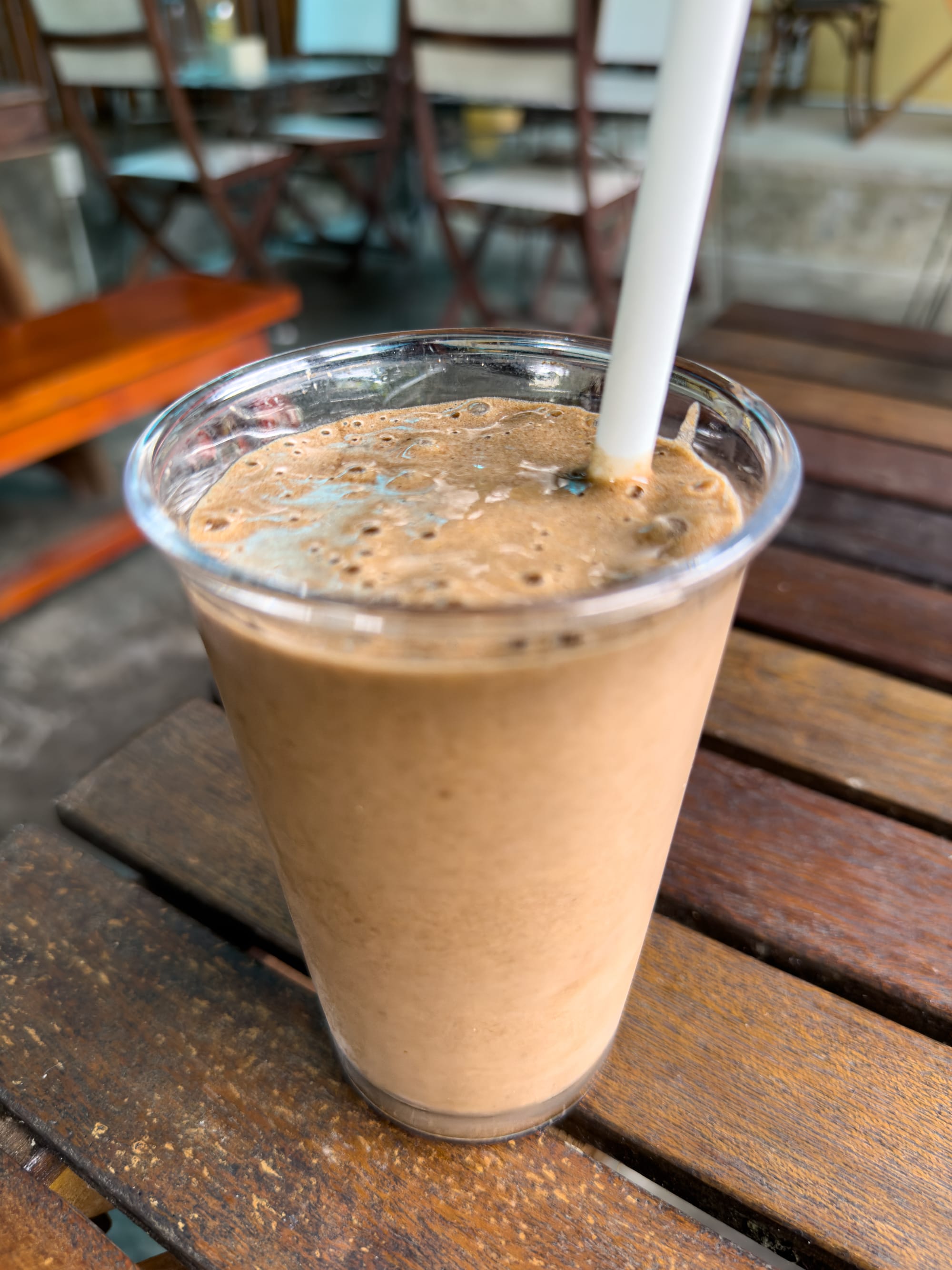
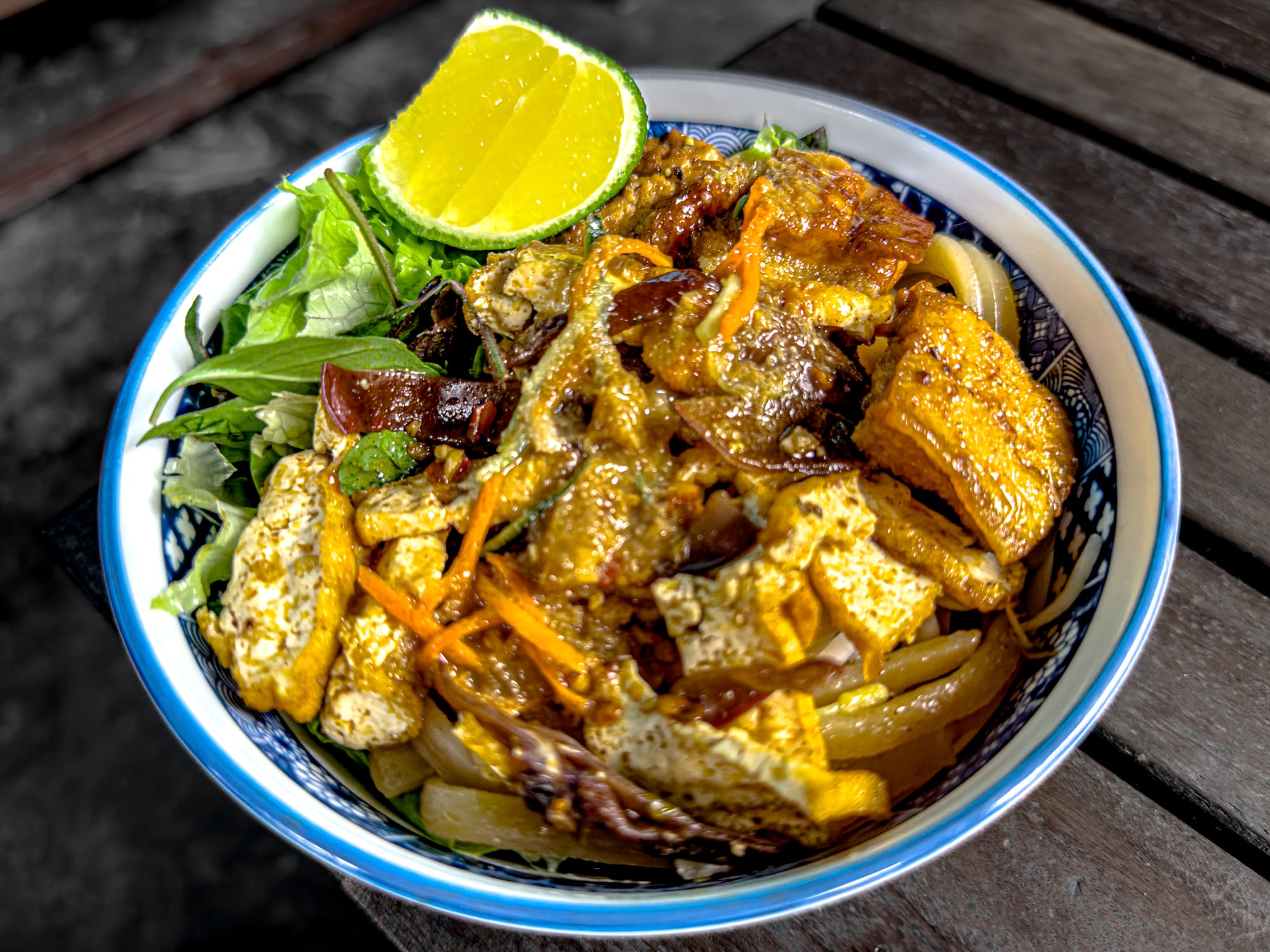
All of our favorite dishes at Chickpea Eatery
And yes, the vegan cheese platter is real—a spread of nut-based cheeses that feels almost surreal in a town this size.
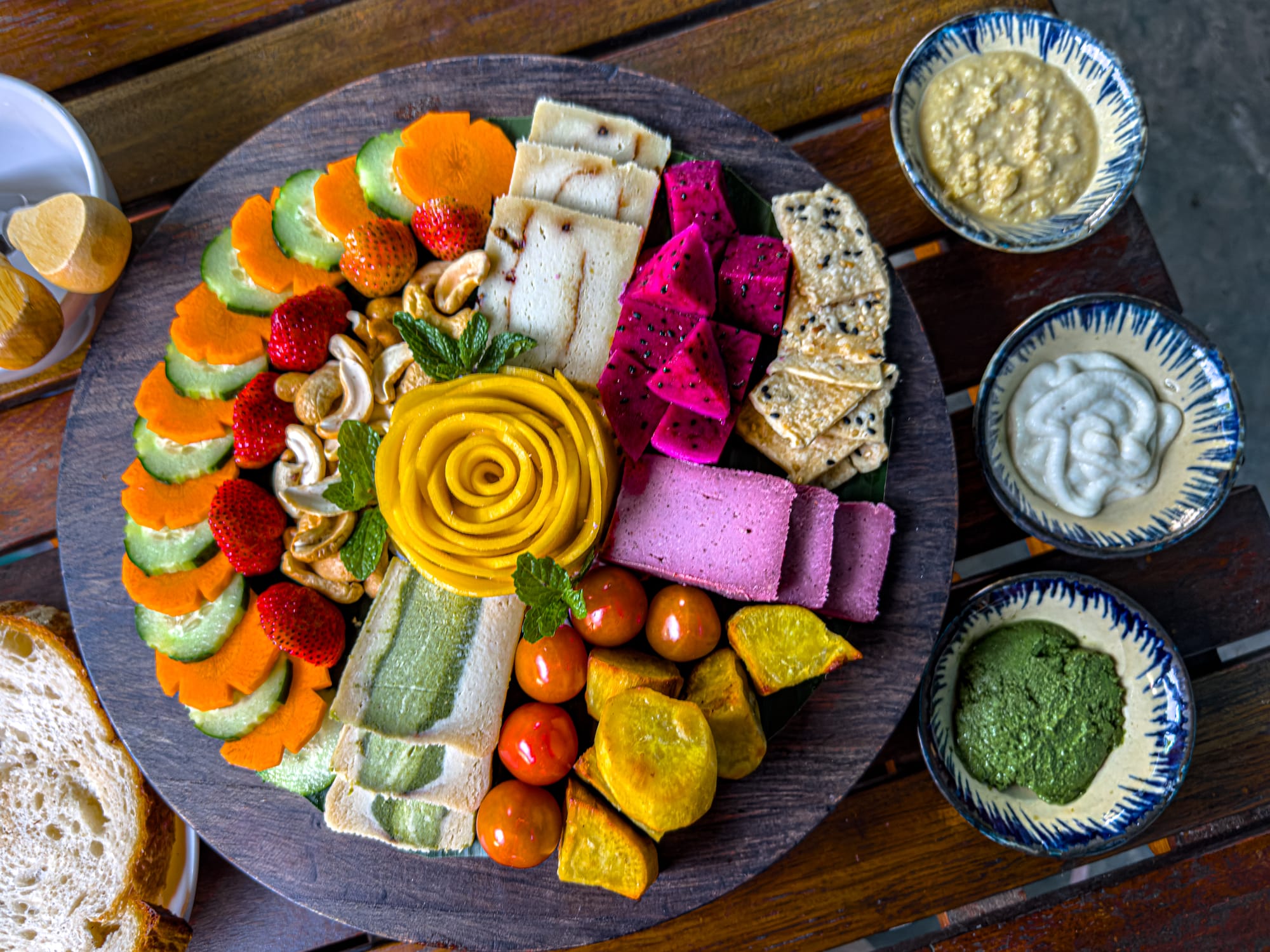
The restaurant has become a gathering place for travelers, digital nomads, and locals alike. It’s the kind of place where you can drop in casually or linger over a meal with friends, where the atmosphere is warm but unpretentious.
Book the class, or just visit the restaurant
You can book Chickpea Eatery's vegan cooking class through their website. Like Rau Ơi's, we also found it ran over the allocated time, in a relaxed and generous way.
If you'd rather not cook, you can try their food at their location in the old town or on Grab.






